

CENTIMETER-LEVEL POSITIONING IN REAL-TIME


HOW TO MAINTAIN PRIVACY IN INDOOR TRACKING
RUN AI MODELS WITH LOW POWER
5G REQUIRES BETTER POWER AMPLIFIERS MACHINE LEARNING TO THE EDGE




CENTIMETER-LEVEL POSITIONING IN REAL-TIME


HOW TO MAINTAIN PRIVACY IN INDOOR TRACKING
RUN AI MODELS WITH LOW POWER
5G REQUIRES BETTER POWER AMPLIFIERS MACHINE LEARNING TO THE EDGE

Automotivedesignersaretransitioningtoacentralizedcomputernetworkinwhichanyserviceand informationcanbeaccessedanywhereinthevehicleusinglow-speedsensors,actuatorsandother edgedevicesthatareeasilyconnectedtothecloudthroughastandardEthernetsystem.
Thefirstautomotive-qualifiedphysicallayer(PHYandMAC-PHY)devicesimplementtheIEEE10BASE-T1S Ethernetstandardwhichreducescostthroughsimplewiring.AlongsidethesePHYsandMAC-PHYs,the 100BASE-T1EthernetswitchfamilysupportsTimeSensitiveNetworkingfortime-stampingfeaturesthat supporttimesynchronization,amongotherTSNfunctionality.Allthesedevicesreducedevelopmenttime andriskthroughusingwell-knownEthernetnetworkingforbothin-vehiclearchitectureandindustrialdesigns.
KeyFeatures
• LAN8670/1/2andLAN8650/1Families,thefirstavailableautomotive-qualified 10BASE-T1SEthernetPHYandMAC-PHYdevicesonthemarket
• LAN938xethernetswitchfamily,offeringanintegratedCPUandFlashMemory for“EthernetReady”outoftheboxoperation
• AutomotiveEngineeringCouncilAEC-Q100qualified
• FunctionalSafetyReadyaccordingtoISO26262specifications



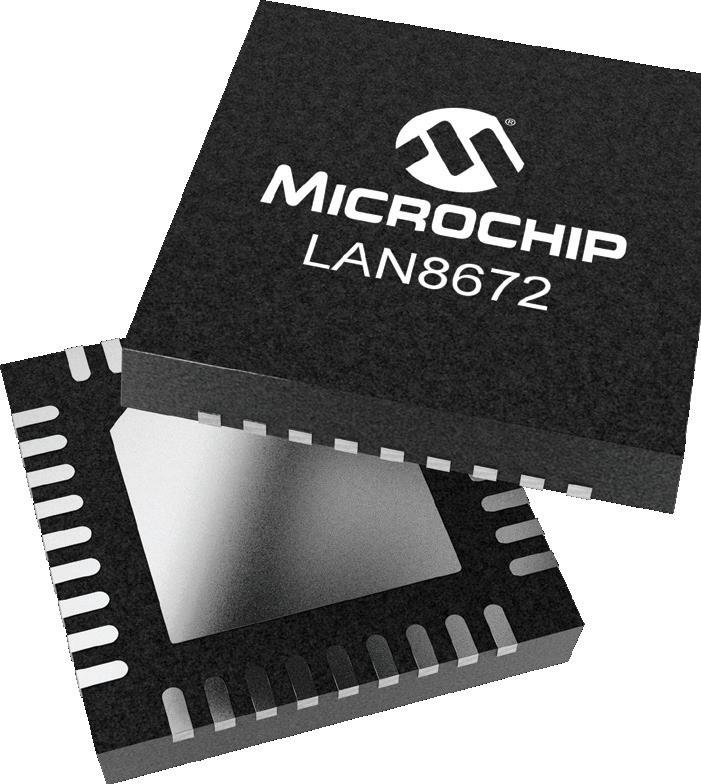

When has the use of AI gone too far?
In April I got a press release in my inbox announcing the world´ s first AI coffee. A roastery let a large language model rate written reviews of different coffees and then suggested a blend that would combine all the great qualities of four different beans. Ever get the idea that it has now gone too far?
The Embedded World in Nuremberg showed that unless your product uses AI, it might go unnoticed. So we saw AI used everywhere. Notably on the edge, with ever descreasing power usage. Soon you´ ll be able to buy a bracelet that has ML models telling if the person has fallen. This will cost 15 USD instead of a few hundred bugs you need to pay for a smart wrist device.
The last time we saw anything like this was in the 90´ s when a thing called internet changed everything. But it didn´ t happen this quick. It took years to push into different areas of our lives. With IoT that revolution is actually still going on.
AI is a quicker beast. It is hard to believe that OpenAI shocked the world with ChatGPT just 18 months ago. Now you don´ t “use” applications anymore. You discuss with them. You ask for advice. You ask how to formulate the best prompt for discussing with a large langugae model.
If you have ever wondered about social media´ s influence on your privacy or your behaviour, you should be terrified about AI. It won´ t take long when AI knows more about you than your mother.
But there is no stopping this. You have to embrace the technology. You need to learn to use it and become critical about AI. That is the only way to keep AI in it´ s place. It is, after all, only a tool.
 Veijo Ojanperä ETN, Editor-in-chief
Veijo Ojanperä ETN, Editor-in-chief


ETNdigi
Editor-in-chief Veijo Ojanperä vo@etn.fi
+358-407072530
Sales manager Anne-Charlotte Lantz +46-734171099
ac@etn.fi
Advertising prices: etn.fi/advertise
ETNdigi is a digital magazine specialised on IoT and embedded technology. It is published 2-3 times a year.
ETN (www.etn.fi) is a 24/7 news service focusing on electronics, telecommunications, nanotechnology and emerging applications. We publish indepth articles regularly, written by our cooperation companies and partners.
ETN organises the only independent embedded conference in Finland every year. More info on ECF can be found on the event website at www.embeddedconference.fi.
The easiest way to access our daily news service is to subscribe to our daily newsletter at etn.fi/ tilaa.

Embedded Conference Finland is the only independent embedded conference in Finland. In September 2024 we will organise the event for the 6th time. The date is September 26!
You can find all the ECF23 presentations on the event website at embeddedconference.fi.
Recordings are online in the ECF Youtube channel. All vital information on future events will be posted on the event website.
ECF24 will focus in embedded technology. We will cover IoT, 5G and AI. Chipsets, integrated circuits, embedded software, measurement and testing tools, power management and systems
For more information see www.embeddedconference.fi
To book a place or ask for sponsor packages please contact
ETN editor-in-chief Veijo Ojanperä vo@etn.fi
+358-407072530 or Sales Manager
Anne-Charlotte Lantz ac@etn.fi
+46-734171099

Embedded World: AI everywhere.
CPX24: AI will keep us safe?
21 TIMETOHIREACHIEFAI OFFICER?
Suggests Piia Hoffsten-Myllylä, the country manager of Kyndryl Finland.
22 RUNAIMODELSONVERY POWER
The RZ/V2H ny Renesas in a unique AI processor that combines the low power and flexibility required by endpoints.
28 5GREQUIRESBETTER POWERAMPLIFIERS
RF systems need power amplifiers (PAs) to deliver linear efficient high output power. Will Gan-on-SiC solve the new PA requirements?
34 POSITIONINGDOWNTO2CM
RAB4 adapter board from Rutronik brings RTK positioning to embedded devices.
38 MAINTAINPRIVACYWHEN TRACKING
Tracking can be done with image sensors, but mmWave radars are better in keeping privacy.
42 MACHINELEARNINGONTHE EDGE
The combination of ST and AWS technologies opens new possibilities for creation of machinelearning applications at the edge.
46 FROMOPTICALANALYSIS TOUBIQUITOUSSENSING



As the industry advances, intelligent platforms for on-the-go sensing are needed. This article will introduce a portable, real-time sensing solution and prototyping platform for rapid liquid sensing. 28
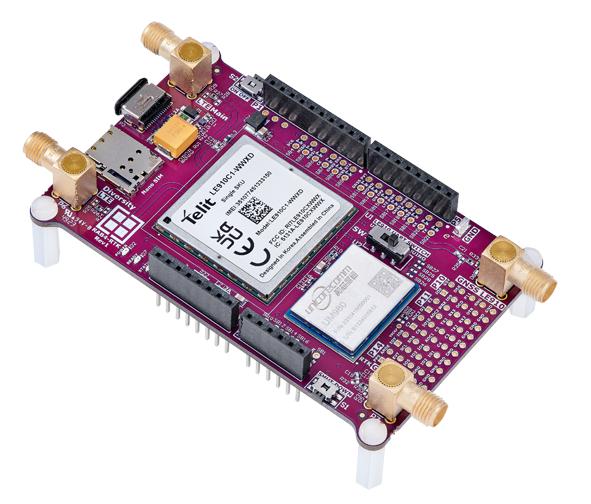

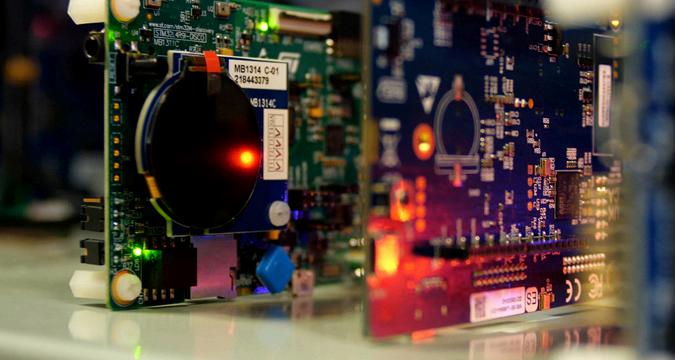

A total of 32 thousand visitors came to Nuremberg for the Embedded World show to hear alla about artificial intelligence. AI was clearly the star of the show, helped by the advances in semiconductor technology. Soon you´ ll enjoy the benefits of AI even in the smallest of wearable devices.
One example of the tiny AI chips was presented by Ambient Scientific, whose founder GP Singh showed the company´s first AI processor at the fair. The GPS10 is a 10 AI core processor manufactured in a 14 nm process. The company is not trying to compete with Nvidia. According to GP Singh, that would make no sense.
- Cerebras and Sambanova are examples of companies that wanted to compete with Nvidia, but it didn't go well. Not even Intel can challenge Nvidia anymore in the data center, says Singh.
Nvidia's dominance is actually a bit ironic. The company has never designed or manufactured AI processors. Its GPU processors just sit well with ChatGPT-like cloud-based AI model processing. The company owns the market, as it practically has no competitors.
- No big company has yet designed an AI microprocessor, Singh reminds. And these startups are the only thing that Nvidia and its CEO Jensen Huang fear. In the end,
they may take away the money-making machine from him.
Ambient Scientific's innovation is architecture. The idea is to do the calculation completely analogically in memory (In-Memory). It won't be possible yet, but the current sub-80 microwatt power consumption of the firstgeneration GPX10 processor shows what is now required to bring AI processing to a small embedded device.
In practice, it means for example, a mini camera of a size of a couple of centimetres, which can recognize objects by itself. Or a medallion that detects if its wearer has fallen. By the way, such a medallion is already coming to the market by the end of the year. It has a GPX10 processor inside and the battery will last for months.- There is also a medallion in the design process, which collects the energy it needs from its surroundings. You can put it around the neck of the elderly and forget about it, Singh describes.
Alif Semiconductor is another young Silicon Valley company that has already made a name for itself as a developer of ultra-low-power artificial intelligence controllers. In Nuremberg the company introduced the market's first wireless circuit supporting Bluetooth and Matter, with its own neural network or NPU processor.
The family is called Balletto. It is based on Alif Semiconductor's advanced MCU architecture with DSP acceleration and NPU processor for fast and low-power execution of AI/ML workloads. The chip can be used for speech recognition, adaptive noise reduction, voice direction, beamforming and sensor data fusion.
Delivered as a WLCSP, the Balletto family offers particularly strong performance in audio and sensor functions thanks to its excellent DSP and AI/ML capabilities and large memory. The Arm Cortex-M55 core of the controller, which reaches a score of 704 at 160 MHz in EEMBC's CoreMark test. DSP power is significantly increased
by the Arm Helium M profile vector extensions.
The artificial intelligence calculation at Balletto is done by the Arm Ethos-U55 neural network processor with a performance of 46 billion operations per second (GOPS). Calculations are supported by a memory of 2 megabytes. The neural network processes AI/ML models up to 15 times more efficiently than a Cortex-M4 processor. This produces excellent results in audio encoding/decoding functions, for example. The chip is capable of running the low-latency LC3 codec, which supports Bluetooth's new Auracast transmission technology.
With the help of artificial intelligence, Alif is revolutionizing, for example, active noise reduction in earphones. Until now, ANC solutions have been based on microphones that listen to background noise. It can then be filtered out with the opposite wave. In the future, noise reduction will be based on AI models, whereby only what should be heard in the audio channel is played according to the model. At the same time, we will get rid of microphones that increase the cost of earplugs.
Of course, artificial intelligence is already being introduced as part of the design process. Even to the design of the

antennas, as Barcelona-based IoT antenna developer Ignion demonstrates. The Oxion development platform shortens the design time of wireless devices. With AWS, IoT device developers can harness the power of artificial intelligence and machine learning in real-time to accelerate antenna design.
Oxion reduces process risks with accurate performance prediction and devicespecific design instructions based on patented algorithms. They take advantage of the real experiences gained from using more than 50 million wireless devices.
In practice, developers are no longer dependent only on the data sheet of a static component, but Oxion offers an interactive digital twin that precisely matches the device requirements.
Oxion builds on Ignion's successful Antenna Intelligence Cloud launched in 2022. The platform does not require cutting-edge RF expertise. Meeting the project's RF requirements is now as easy as building with LEGOs, Ignion praises.
Real-time drag-and-drop functionality and instant performance feedback allow developers to modify the design and decide on antenna component, placement, component spacing, and PCB size. After registration, users are presented with customized

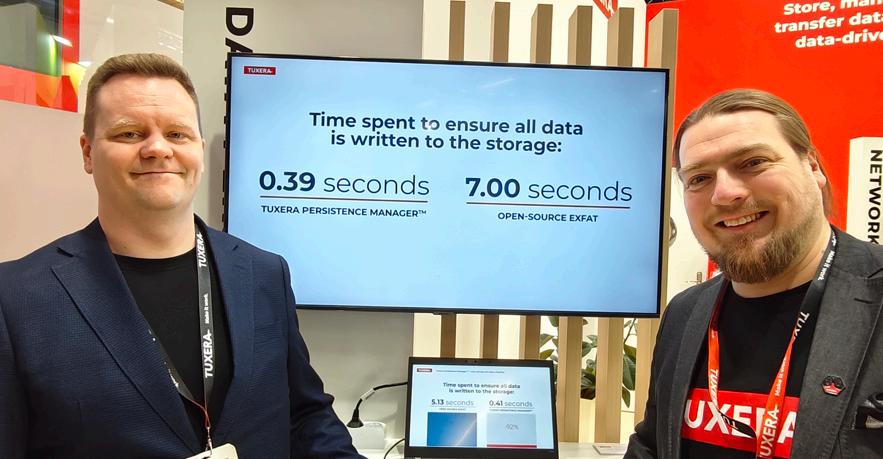
recommendations for a specific device to be built.
There were ten Finnish companies at Embedded World. Companies like Basemark, Bittium. CoreHW, Qt, Unikie and Wirepas are all well known to the embedded audience. The CEO of Radientum Jukka Sjöstedt showed their new innovations: transparent antennas and antennas embedded in fabric.
Tuxera of Espoo launched their Persistence Manager, which is an exFAT file system add-on for Android and Linuxbased embedded systems that improves data resilience. CEO Tuukka Ahoniemi and VP of priduct management Marko Finnig told ETN that Persistence Manager is HW driver that ensures that data is preserved and available. In the case of car dashboard cameras, video data can serve as evidence in the event of a traffic accident, for example.
According to Finnig and Ahoniemi, Persistence Manager stores data in a twosecond time window. In the open source solutions the window is up to 30 seconds. In practice, it is about whether we know what has happened or not. In DVR recorders, the recording window could be extended with a supercapacitor, but it is a more expensive solution.- Our smart code replaces an expensive component, Finnig and Ahoniemi said.
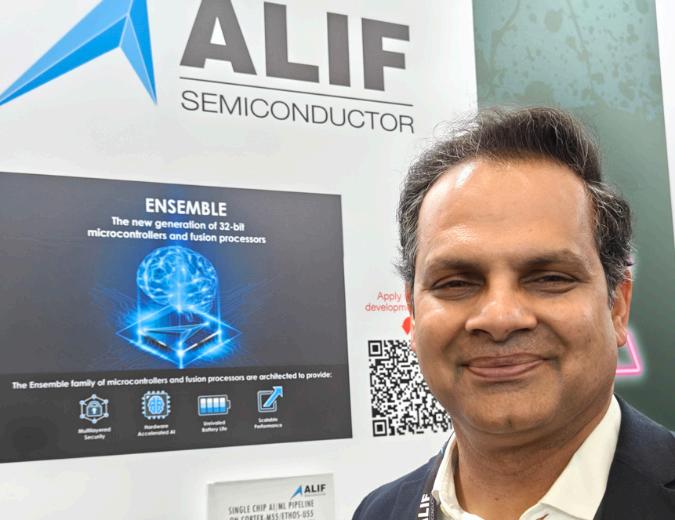
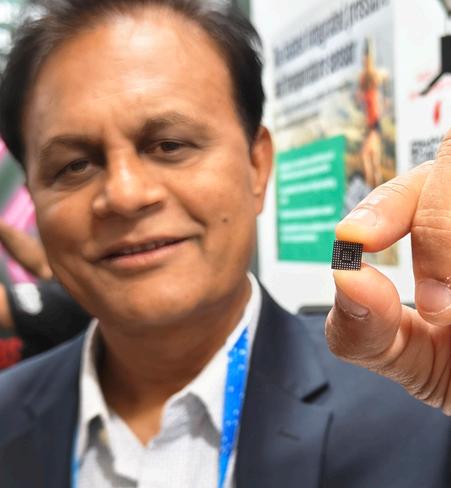
ChatGPT has only been around for year and a half, but it has already revolutionized, for example, the preparation of phishing messages. Now the cyber security companies are deploying the same weapons. Check Point CEO Gil Shwed raved about the new Infinity AI Copilot tool. - The use of artificial intelligence is now being taken to a new level, he said at CPX2024.
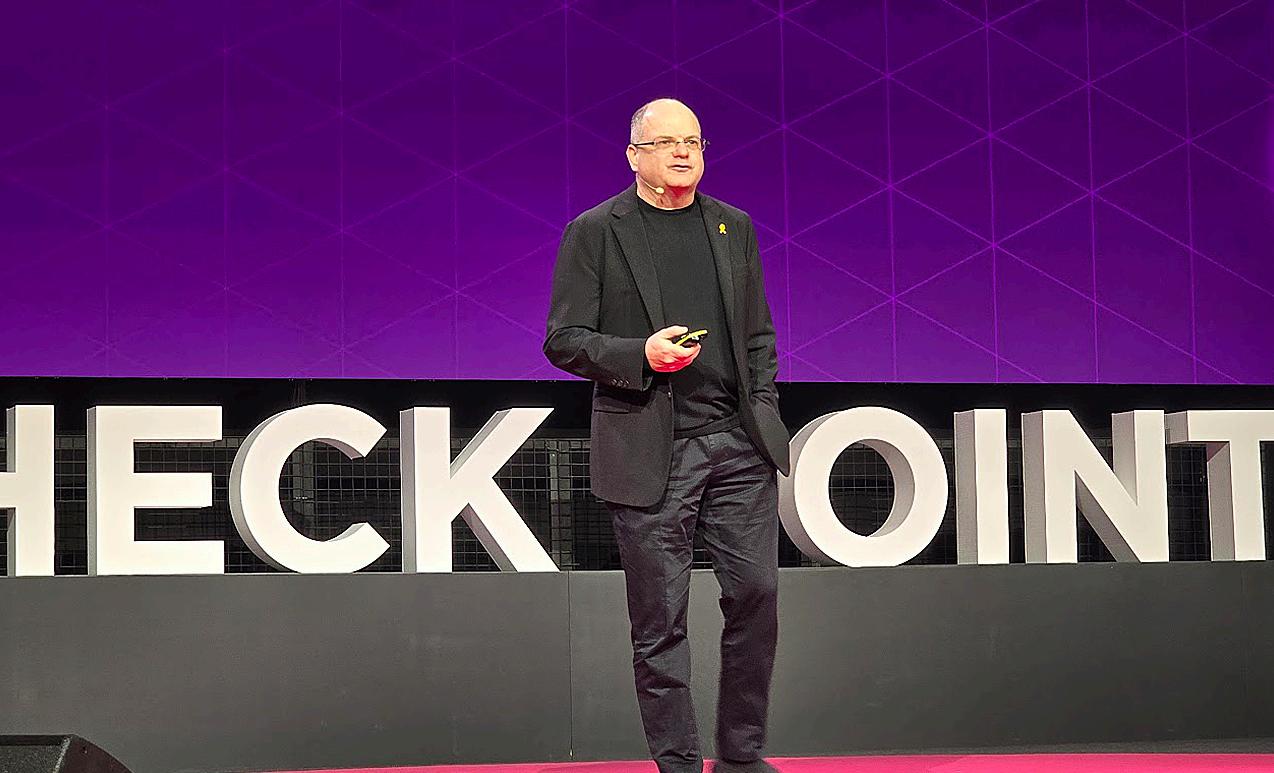
There is guaranteed to be a demand for intelligent automation in the fight against cybercriminals. Last year there were more than 5,000 mega-class ransomware attacks, a full 90 percent more than the previous year. According to Gil Shwed, this was largely based on the use of artificial intelligence.
- The year 2024 is a turning point for cyber security. The only way to fight against threats is a cloud platform that relies on artificial intelligence. AI must become a part of work routines. The new Infinity AI Copilot moves artificial intelligence from the backend to the foreground, i.e. to the desktop of the information security analyst, Shwed pointed out.
Infinity AI Copilot is a tool that can be used to create new information security policies. It can be used to list, for
example, the malware families found in the last 7 days or to ask if the device is protected against a certain vulnerability. - Copilot can also be used to add rights to users, Shwed introduced.
Shwed stressed that detection is not enough. Attacks must be prevented in advance instead of the company's network being at risk 2-3 times a week.
In Check Point's roadmap, Copilot will be implemented in all products in the future. Ofir Israel, director of threat prevention products, said that Copilot is not only based on OpenAI's LLM models, but also on open Llama models. The models are different and future copilots are supposed to decide in flight which model to use.
What if artificial intelligence helps you craft the perfect fishing message? Is that
game over? According to Ofir Israel, the perfect fishing message is only a matter of time. However, it does not mean the end for defence.
- We don't just look at certain points in the phishing message, we have to look at what happens after receiving the message. An attack is always a chain of events that can be stopped.
Years ago the cyber warfare was already described as a battle of two fighting AIs. How close to this reality are we now, with the large language models?
Check Point has been using AI for 11 or 12 years. It makes sense for defenders to use AI when the attack is not known, says Ofir Israel, VP of threat prevention products atCheck Point.- Machine learning can be used to identify the threat.
According to Israel ChatGPT brought about a change, but it didn't give the attackers an advantage.- GenAI gave the defenders more benefits than the attackers. Attacks based on GenAI are nothing new. Deepfake videos are an old idea. What GenAI does is making the attacks attacks more accessible.
For Check Point is doesn´t matter whether they see a million or a billion files a day.- Customers need more sophisticated tools, because the weapons are more capable.
And the new AI Copilot helps to use existing tools more effectively. Less knowhow is needed to set up or improve security.- Eventually we will integrate Copilot into every tool, Ofir Israel said echoing Gil Shwed´s message.
The Check Point Copilot uses several LLM models. The tool knows which one to use. At the moment the tool uses GPT-4 and Llama.
Eventually AI malware will learn to hide itself completely, leaving no markers to be discovered. According to Ofir Israel this is inevitable.
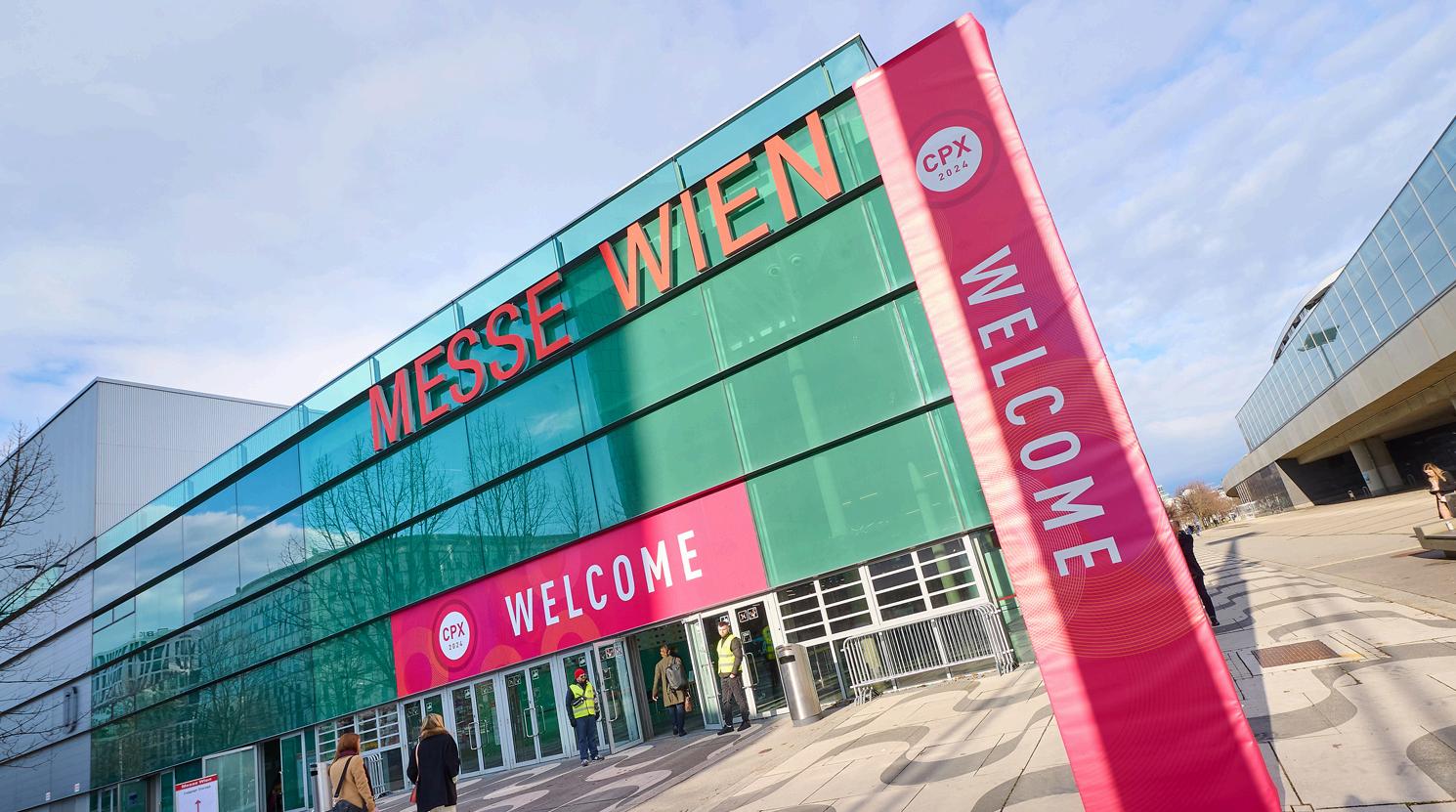

Check Point Software´s country manager for Finland, Viivi Tynjälä, and Jukka Saarenmaa, who is responsible for operations in Northern Europe, reminded that sometimes even single email can be enough to cause a big disaster in companies.
- If we are talking at the level of Northern Europe, it is necessary to say that the information security of communications is generally on the verge all the time. Security guards must stay one step ahead. Detection is no longer enough, attacks must be prevented, Saarenmaa said.
Tynjälä agrees.- It still amazes me that we need to talk to companies about the need for e-mail data security. Most attacks take place via e-mail, and ransomware can drive a company all the way to bankruptcy. Even one email can be enough for this, Tynjälä reminded.
Ransomware has really exploded in the last year. At the same time, attackers
are making more and more use of artificial intelligence.- Generative artificial intelligence makes all of this even more dangerous. You don't have to be from Finland, you don't even have to know how to code. It is really difficult to determine from the incoming message whether it is legitimate or not, Tynjälä said.

Ransomware is now being talked about a lot in the information security industry. However, Jukka Saarenmaa considers data manipulation to be an even bigger problem than theft.- Data manipulation can have bigger effects on business.
A large part of product services are currently purchased as a service, SaaS-
style. According to Saarenmaa, this model has started with small and medium-sized companies.- SMEs haven't had the ability to tender all parts, while the big ones want the best possible from every area.
Now the SaaS model is advancing rapidly everywhere. Increasingly, only usage is paid for. For end users, the solution only appears as a service that is paid for on a monthly basis. According to Viivi Tynjälä, the model also brings security to customers, as the tools can be adapted to business cycles.
But even though there is a transition from on-premises-type devices to users of cloud services, according to Saarenmaa, it is important to take care of the basics. Like that email security thing.
- Fortunately, you don't get a call every day that the company has had a data breach, but they do happen regularly. We are not running out of work.
SiTime of Santa Claras is known for its MEMS timing chips, which have gradually replaced quartz crystals in the timing of chips and systems. Now the company is taking the biggest technological step so far with the introduction of clock generator circuits. SiTIme calls these devices clock-systems-on-a-chip, or ClkSoCs in short.
The new product family is called Chorus. According to SiTime, the circuit family offers 10 times better performance in half the size compared to standalone oscillators and clocks. Chorus is a singlechip solution that includes clock, oscillator and resonator technologies on an integrated chip. This simplifies the design of the system clock architecture, which speeds up the design.
SiTime's Marketing Director Piyush

Sevalia reminds us that artificial intelligence increases enormous needs for greater data transfer and lower power
consumption in data centers.- Before Chorus, hardware designers had to use separate product types such as clocks, oscillators and resonators, leading to performance compromises. Chorus solves these problems with a single integrated clock generator.
Chorus, with its integrated MEMS resonator, addresses the limitations of legacy clock generators, eliminating problems such as noise and matching the resonator's impedance with the clock. Also, Chorus can reduce the board area for timing by up to 50% by replacing up to four standalone oscillators. Datacenter equipment such as servers, switches, acceleration cards and smart network interface cards (NICs) are ideal applications for Chorus.
More info here.

Precise positioning has become increasingly important in many areas and applications. Real-Time Kinematic (RTK) offers significantly greater accuracy than conventional multiGNSS systems and continues to grow in cost-effectiveness. Together with the Rutronik Wireless Competence Center, the experts from Rutronik System Solutions have developed the Adapter Board RAB4, which facilitates testing the performance of RTK without designing any hardware. By accelerating the pre-development phase and reducing costs, the RAB4 helps to bring applications to market faster.
The RAB4 features high-performance components, all available on the Rutronik Linecard. The high-precision UM980 RTK positioning module from Unicore Communications uses the latest generation of the NebulasIV GNSS SoC, offers a high positioning rate, and supports all available GNSS frequencies. It is ideal for navigation and
positioning applications.
For absolute positioning, a 4G LTE module with an integrated standard multi-GNSS receiver from Telit Cinterion's LE910 series is integrated on the Adapter Board. Another advantage is that the integration of a GNSS and RTK receiver makes it possible to compare the outputs directly with each other without having to use several development kits from different suppliers. The RAB4 also includes a 100 MB prepaid SIM card. Thanks to this combination, NTRIP correction data can be downloaded from the Internet. It is not necessary to operate an own reference station.
Thanks to the Arduino interface, the RAB4 is easy to combine with other boards like the RDK3 from Rutronik System Solutions, a Base Board that allows wireless connections to be realized using Bluetooth Low Energy.
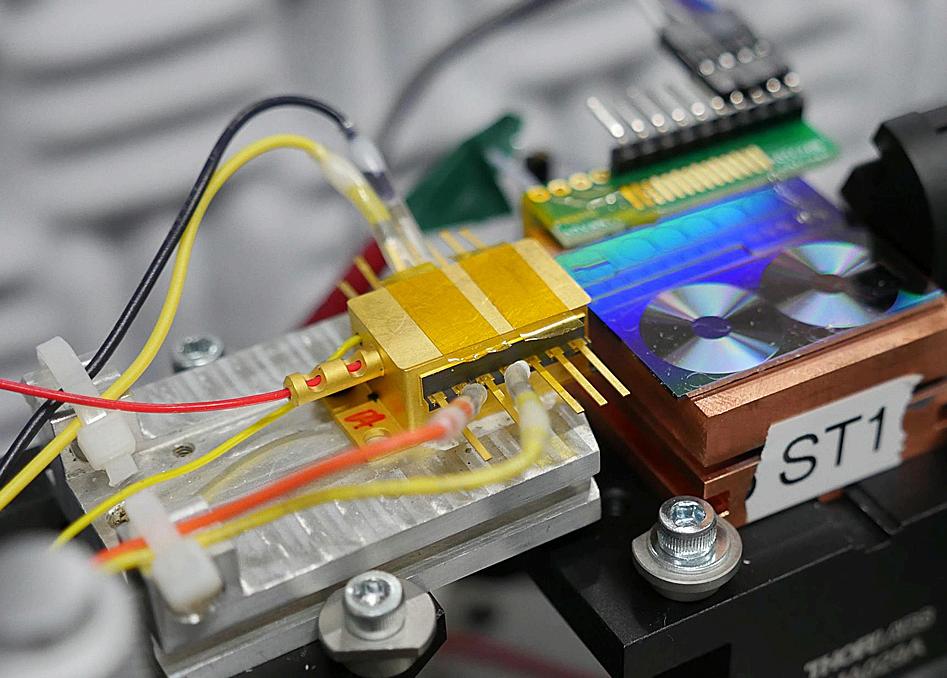
The National Institute of Standards and Technology (NIST) and its collaborators have delivered a small but mighty advancement in timing technology: compact chips that seamlessly convert light into microwaves. This chip could improve GPS, the quality of phone and internet connections, the accuracy of radar and sensing systems, and other technologies that rely on high-precision timing and communication.
This technology reduces something known as timing jitter, which is small, random changes in the timing of microwave signals. Similar to when a musician is trying to keep a steady beat in music, the timing of these signals can sometimes waver a bit.
NIST researchers reduced these timing wavers to a very small fraction of a second — 15 femtoseconds to be exact, a big improvement over traditional microwave sources — making the signals much more stable and precise in ways that could increase radar sensitivity, the accuracy of analog-to-digital converters and the clarity of astronomical images captured by groups of telescopes.
What sets this demonstration apart is the compact design of the components that produce these signals. For the first time, researchers have taken what was once a tabletop-size system and shrunken much of it into a compact chip, about the same size as a digital camera memory card. Reducing timing jitter on a small scale reduces power usage and makes it more usable in everyday devices.
Right now, several of the components for
this technology are located outside of the chip, as researchers test their effectiveness. The ultimate goal of this project is to integrate all the different parts, such as lasers, modulators, detectors and optical amplifiers, onto a single chip.
By integrating all the components onto a single chip, the team could reduce both the size and power consumption of the system. This means it could be easily incorporated into small devices without requiring lots of energy and specialized training.
According to NIST physical scientist Frank Quinlan, the current solutions take several labs and many Ph.D.s to make microwave signals happen,.- A lot of what this research is about is how we utilize the advantages of optical signals by shrinking the size of components and making everything more accessible.”
To accomplish this, researchers use a semiconductor laser, which acts as a very steady flashlight. They direct the light from the laser into a tiny mirror box called a reference cavity, which is like a miniature room where light bounces around. Inside this cavity, some light frequencies are matched to the size of the cavity so that the peaks and valleys of the light waves fit perfectly between the walls.
This causes the light to build up power in those frequencies, which is used to keep the laser’s frequency stable. The stable light is then converted into microwaves using a device called a frequency comb, which changes high-frequency light into lower-pitched microwave signals.
Microchip Technology has introduced the RT PolarFire system-on-chip (SoC) FPGA. Developed on Microchip’s RT PolarFire FPGA, it is the first realtime Linux capable, RISC-V based microprocessor subsystem on a flight-proven RT PolarFire FPGA fabric. Systems deployed in space are subjected to harsh radiation, prompting design methodologies that can provide protection for the most critical radiation-induced upset types. Unlike SRAM FPGAs, the RT PolarFire SoC is designed for zero configuration memory upsets in radiation.
-> etn.fi/16161
Rohde & Schwarz has teamed up with IPG Automotive, to redefine automotive radar Hardware-inthe-Loop (HIL) integration testing and thereby reducing the cost by bringing Autonomous Driving (AD) testing from the proving ground to the development lab. Combining the CarMaker simulation software from IPG Automotive with the R&S AREG800A radar object simulator and the R&S QAT100 advanced antenna array provides vehicle manufacturers with the ability to simulate ADAS/AD scenarios like those defined in the Euro NCAP.
-> etn.fi/16150
Ambiq Micro of Austin, Texas has introduced the new Apollo510, the first member of the Apollo5 SoC family, which is uniquely positioned to kickstart the age of truly ubiquitous, practical, and meaningful AI. The MCU is a complete overhaul of hardware and software that fully leverages the Arm Cortex-M55 CPU with Arm Helium™ to reach processing speeds up to 250MHz. The Apollo510 achieves up to 10x better latency while reducing energy consumption by around 2x, compared to Ambiq’s previous power efficiency leader, the Apollo4.
-> etn.fi/16148
RAB4-RTK
RutronikAdapter
Boardforcentimeterpercisepositioning inreal-timewithRTK technology
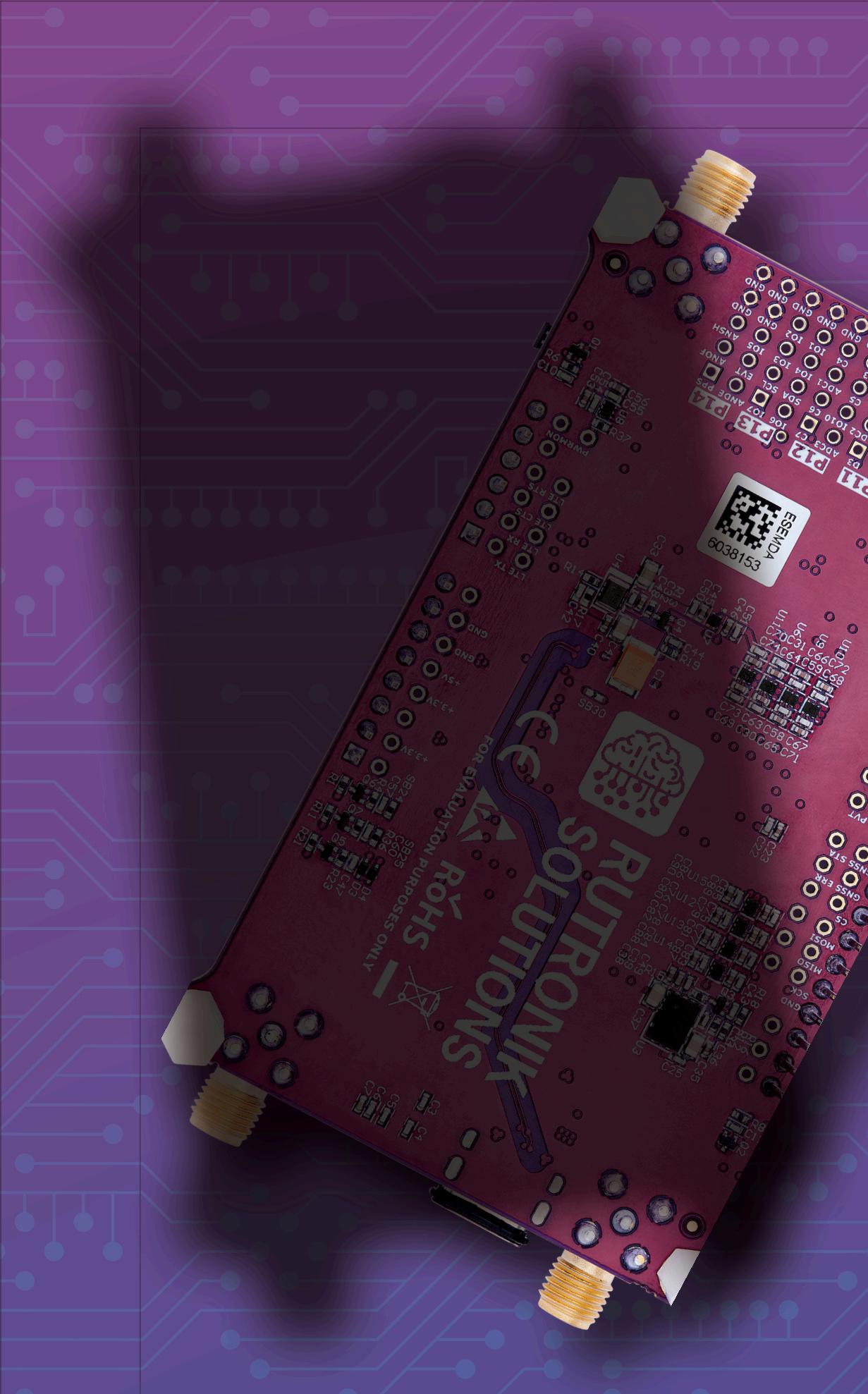
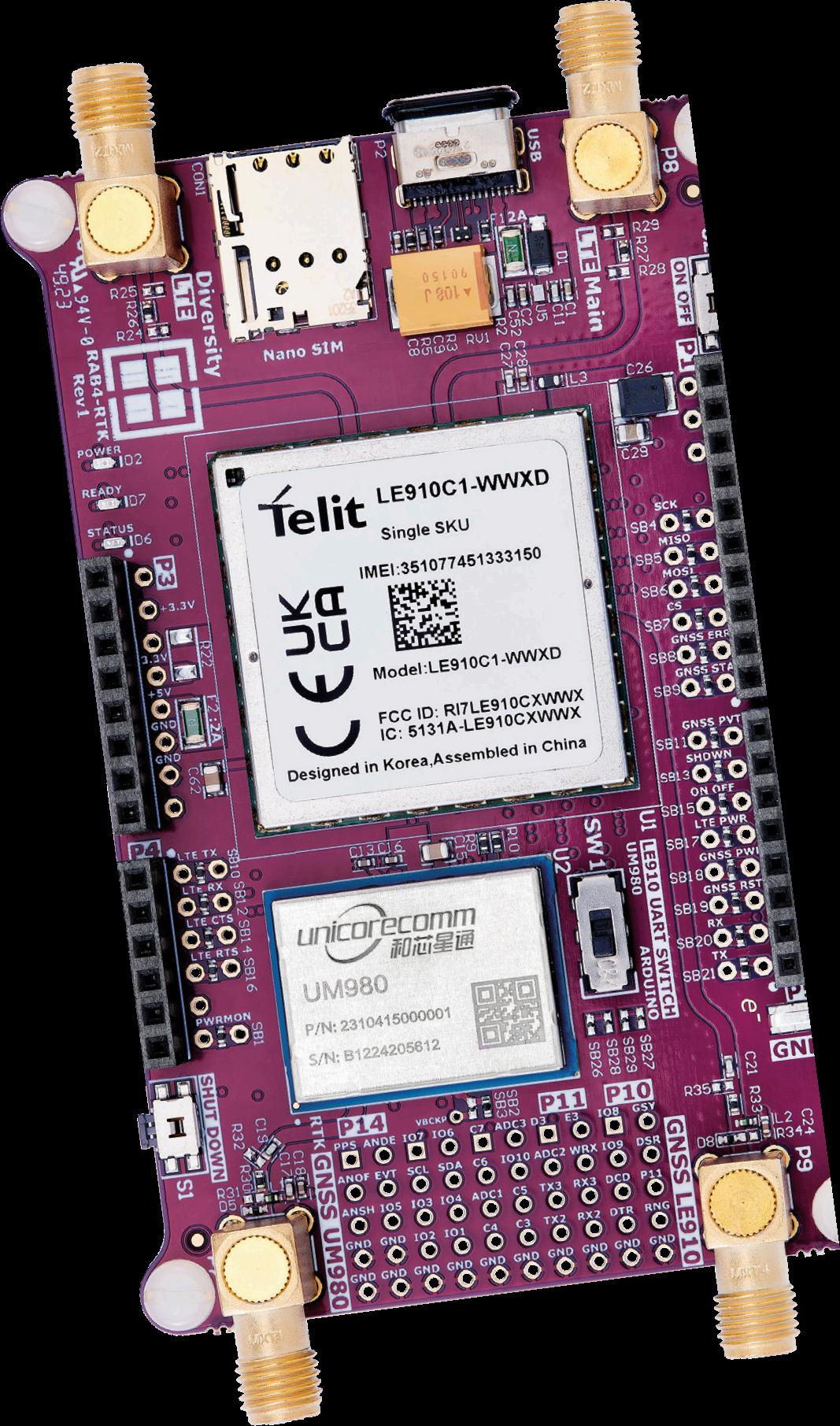




Real-TimeKinematic(RTK)offerssignificantlygreateraccuracythanconventionalmultiGNSSsystemsandcontinuestogrowincost-effectiveness.TogetherwiththeRutronik WirelessCompetenceCenter,theexpertsfromRutronikSystemSolutionshavedeveloped theAdapterBoardRAB4,whichfacilitatestestingtheperformanceofRTKwithoutdesigning anyhardware.Byacceleratingthepre-developmentphaseandreducingcosts,theRAB4 helpstobringapplicationstomarketfaster.
www.rutronik.com


The components market is very uncertain at the moment. Companies are trying to get rid of their large inventories, so no one bays anything. But soon there will be a strong increase in demand, says Mark Burr-Lonnon (pictured above), who is responsible for the European operations of component distributor Mouser.
- The turn will probably come already in the third quarter, at the latest in the middle of next year, he estimates.
Allocation is of course nothing new in distribution. In electronics cycles follow each other and demand and capacity are rarely in sync.- The industry does not learn, and does not want to learn. Allocation always allows manufacturers to reprice the market, Burr-Lonnon says.
According to Burr-Lonnon, Mouser looks at all this from a slightly different angle.
- The number of customers and buyers is growing all the time. The number of orders is increasing. New designs are being made at an accelerating pace, BurrLonnon emphasizes.
When the market returns to normal, manufacturers' inventories must be in order. Last year, it was estimated that everything should be normal in September 2023.- Now we are talking about the third quarter, so more components are needed at the end of the year. And we will need a lot of them. If manufacurers are not ready to respond to this demand, we will see another allocation and a rise in prices.
There are already signs of this. Memory prices have gone up, this is usually the
first sign.- Condensator and connector leads times are getting longer. The EMS companies call us when they are in trouble. All this tell us that we are at a turning point and the rise will begin soon.
According to Burr-Lonnon, Mouser is ready for future growth.- In a way, we are lucky. We have a million square feet of warehouse space in Texas and after the first quarter of next year the area will double. We will soon have enough ware house capacity to have two billion dollars worth of components in stock. We are more prepared than others.
At the Embedded World in Nuremberg artificial intelligence was seen on almost every stand. According to Mark BurrLonnon AI is also the engine of the coming growth.- The importance of artificial intelligence is huge, although almost no one yet fully understands what it really is. We know that there will be a huge number of applications that utilize AI technologies. And this will drive component sales for years to come. Our mission is to continually expand the technologies that can accelerate these designers. We may not know what will happen, but we will provide the right components for that, Burr-Lonnon assures.
Last year, Mouser estabslished a new office in Lithuenia. Mouser´s Finnsih customers are served from the new office. Last year the Finnish customers generated almost 20 million euros worth of sales for Mouser. But According to Mark Burr-Lonnon, it could certainly be more.
- There are many startups in Finland, so there is potential for growth, he says.
Qualcomm Technologies has expands the Snapdragon X Series platform portfolio with Snapdragon X Plus. It features the state-of-the-art Qualcomm Oryon CPU, a custom-integrated processor that delivers up to 37% faster CPU performance compared to competitors, while consuming up to 54% less power1. Snapdragon X Plus is also designed to meet the demands of on-device AI-driven applications, powered by the Qualcomm® Hexagon™ NPU capable of 45 TOPS, making it the world’s fastest NPU for laptops. This platform is a significant leap in computing innovation and is set to transform the PC industry.
-> etn.fi/16147
Canatu of Helsinki, Finland is investiong 10 Million EUR to grow its carbon nanotube film production capacity. Canatu has doubled its working for during the last 18 months and emplys 120 people at the moment. New production capacity should be operational by the end of 2024. The new clean room confirms to ISO3 class requirements.
-> etn.fi/16144
UNIKIE BRINGS FULLY AUTOMATED DRIVING TO PORT
Unikie plays a pivotal role in the groundbreaking AutoLog research project aiming at fully automated driving in large automotive seaports and compounds around the world. Partnering with Volkswagen Group Logistics, Deutsche Telekom, and BIBA – Bremer Institut für Produktion und Logistik, Unikie is set to redefine operational efficiency and mixed-traffic navigation in gated areas, starting at Europe’s thirdlargest automotive seaport in Emden, Germany. Unikie will implement the state-of-the-art Unikie Marshalling Solution, UMS, in the AutoLog project to enable fully automated vehicle movements without human intervention.
-> etn.fi/16139
Keysight Technologies has introduced RFPro Circuit, a next-generation radio frequency (RF) simulation tool targeting the complex, multi-physics requirements of today's RF integrated circuit (RFIC) designers. Wireless, automotive, and satellite designers can now deliver robust designs that overcome performance challenges in dense 3D packaging, taking advantage of interoperability and automation to form complex workflows.
RFPro Circuit features a new modular architecture that ensures a consistent, streamlined environment for multiphysics co-design across Cadence, Synopsys, and Keysight electronic design automation (EDA) platforms. Optional electromagnetic (EM) and electro-thermal simulators also plug into this new environment, enabling faster design and troubleshooting of wireless RFICs.

Typically, RFIC designers perform sequential, single-domain verifications using expert tools, but have a difficult time identifying and troubleshooting multi-domain design issues until the end of the design process. Designers are often required to become domain experts, shouldering the overhead of setup and database manipulations for each tool. With the new RFPro Circuit simulator, these tools are more tightly integrated into highly automated and efficient workflows.
In addition to EM and electro-thermal simulators, Keysight provides RF-aware analyses for stability, system-level modulation and waveforms, and simulator settings. For example, designers can optimize a sophisticated 5G-Advanced power amplifier for error vector magnitude (EVM) while loaded with EM package parasitics. As 3D designs become denser and move into new millimeter wave frequencies, Keysight now offers a path to efficient design flows that are not only robust, but reliable enough to be used for training tomorrow's artificial intelligence and
AMD had announced the Spartan UltraScale+ FPGA family, which is the newest addition to the portfolio of CostOptimized FPGAs and adaptive SoCs. Delivering cost and power-efficient performance for a wide range of I/Ointensive applications at the edge, Spartan UltraScale+ devices offer the industry’s highest I/O to logic cell ratio in FPGAs.
The devices deliver up to 30 percent lower total power consumption versus the previous generation, and contain the most robust set of security featuresiii in the AMD Cost-Optimized Portfolio.
Build on 16 nm process technology the Spartan UltraScale+ FPGAs are optimized for the edge, delivering high I/O counts and flexible interfaces which allow the FPGAs to seamlessly integrate and

efficiently interface with multiple devices or systems to address the explosion of sensors and connected devices.
machine learning automation in leadingedge microwave applications.
Beyond RFPro Circuit's numerous technical improvements, Keysight offers a flexible licensing model that gives RFIC designers greater simulation freedom and instant access to the latest features, in order to adapt to changing workflows on a daily basis. RFPro Circuit is available for immediate download for the Cadence Virtuoso and Synopsys Custom Compiler environments. Availability for the Keysight ADS environment is expected in late 2024.
The family offers the industry’s highest I/O to logic cell ratio with up to 572 I/Os and voltage support up to 3.3V, enabling any-to-any connectivity for edge sensing and control applications. The proven 16nm fabric and support for a wide array of packaging, starting as small as 10x10mm, provide high I/O density in an ultra-compact footprint.
The Spartan UltraScale+ family is estimated to offer up to a 30 percent reduction in power compared to the 28nm Artix 7 family, through 16nm FinFET technology and hardened connectivity. They are the first AMD UltraScale+ FPGAs with a hardened LPDDR5 memory controller and PCIe® Gen4 x8 support, providing both power efficiency and future-ready capabilities for customers.
Silicon Labs has presented its most energy-efficient IoT system chips to date. The XG22E series chips are intended for devices that get the power they need by energy harvesting. The chips in the series still have a radio that supports both Bluetooth Low Energy, customerspecific 802.15.4 and sub-gigahertz connections.

The new product family is SiLabs' first series designed for energy harvesting. The new family consists of the BG22E, MG22E and FG22E versions. Applications include batteryoptimized and battery-free devices that can collect energy from external sources in their environment, such as indoor or outdoor lights, environmental radio waves and movement.
At the same time, Silicon Labs announced its partnership with epeas, one of the leading suppliers of power management circuits designed for energy harvesting. Through the partnership, Silicon Labs and e-peas jointly developed two energy harvesting add-on cards for the new, SoCs. (xG22E Explorer Kit pictured left).
Many of the features of the xG22E series chips meet the requirements of IoT designers. Such is, for example, an ultra-fast, low-power cold start for applications that start from a zero-energy state to send packets and then quickly return to sleep. The XG22E device wakes up in just eight milliseconds and uses only 150 microjoules of energy to do so.
STMicroelectronics has introduced a new generation of energy-conscious and costeffective microcontrollers (MCUs) that can reduce energy consumption by up to 50% compared to previous product generations. This enables less frequent battery replacements, minimizes the impact of discarded batteries, and allows more designs to go battery free running solely from an energyharvesting system such as a small photovoltaic cell.
working will demand billions more.

In the global pursuit of sustainability, technologies deployed in smart buildings and Internet of Things (IoT) applications are critical tools for managing energy and resources efficiently. At the heart of the smart sensors and actuators making them possible, ST’s microcontrollers manage the processes that collect, filter, analyze, and act, communicating with high-level applications in the cloud. There are billions of these MCUs in action already and the expansion of smart living and
The STM32U0 enhances costeffectiveness by providing an LCD segment display controller. Devices with an LCD can take advantage of this to reduce the cost of their PCB. Additional value-added features of STM32U0 MCUs include numerous analog peripherals like analog-to-digital converters (ADC), digital-to-analog converters (DAC), operational amplifiers, and comparators. There is also an on-chip system oscillator that helps cut the bill of materials to save costs and PCB space.
STM32U0 devices are the first MCUs running on Arm Cortex-M0+ targeting SESIP Level 3 and PSA level 1 focusing on firmware code protection. Certification provides an independent assurance of the STM32U0 security capabilities that comply with the coming voluntary US Cyber Trust Mark and mandatory EU Radio Equipment Directive (RED).
Samsung has begun mass production for its one-terabit (Tb) triple-level cell (TLC) 9thgeneration vertical NAND. With the industry's smallest cell size and thinnest mold, Samsung improved the bit density of the 9th-generation V-NAND by about 50% compared to the 8thgeneration. New innovations such as cell interference avoidance and cell life extension have been applied to enhance product quality and reliability, while eliminating dummy channel holes has significantly reduced the planar area of the memory cells.
-> etn.fi/16128
Silicon Labs has announced thexG22E family of Wireless SoCs, Silicon Labs' first-ever family designed to operate on harvested energy. The family consists of the BG22E, MG22E, and FG22E. All three SoCs will enable IoT device makers to build Bluetooth Low Energy (LE), 802.15.4-based, or proprietary 2.4GHz wireless devices for battery-optimized and batteryfree devices that can harvest energy from external sources in their environments like indoor or outdoor ambient light, ambient radio waves, and kinetic motion.
-> etn.fi/16125
Nokia has announced that the first Buy America-compliant products have rolled off the Sanmina manufacturing line. This significant milestone underscores the company’s commitment to providing BEAD applicants with the broadband technology needed for critical infrastructure projects. The first Nokia products to come off the Sanmina manufacturing line are its Optical Line Terminal (OLT) cards, which help connect users to fast, reliable gigabit data services. These devices are critical in fiber networks, ensuring broadband data gets to and from homes or businesses. .
-> etn.fi/16135
WiTTRA’s new hybrid mesh network architecture integraties sub-GHz and UWB technologies. The solution is revolutionary with its unified network architecture, blending UWB/6LoWPAN and Mioty LPWAN technologies into a single framework. This integration represents a strategic reimagining of asset-tracking infrastructures, aiming for unparalleled adaptability and user-centricity..
WiTTRA’s network architecture not only supports a wide range of location accuracies but also boasts compatibility with thousands of thirdparty sensors, as a compliment to location data, to increase the richness of the data set available to the customer.
-> etn.fi/16117
BeagleBoard.org Foundation is bringing back the open nature of early computers with BeagleY-AI, a move critical to innovation, business and education. BeagleY-AI is about the size of a business card and is compatible with popular accessories, add-on hardware and enclosures available for similar sized computers, but it is open source hardware, runs well without a fan and includes programmable processors capable of running 4 trillion operations per second (4 TOPS) suitable for executing deep learning algorithms.
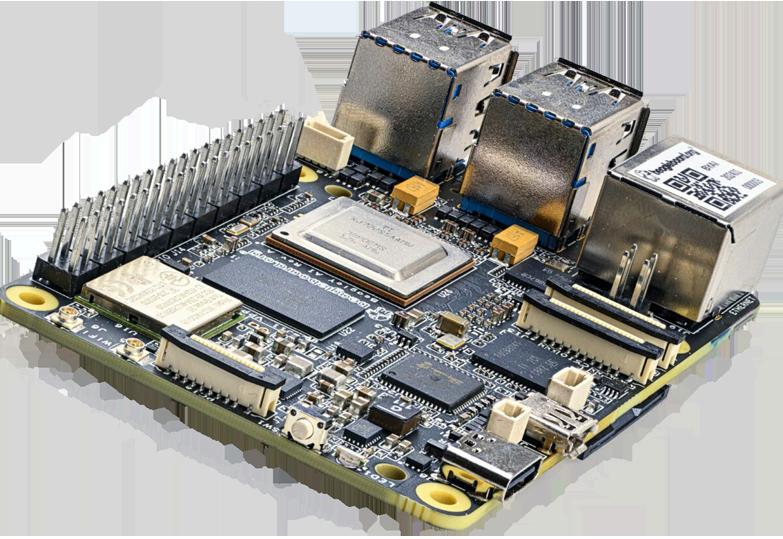
BeagleY-AI leverages broadly available and industrial proven Texas Instruments processors, specifically the AM67A system-on-chip (SoC), which features a quad-core 64-bit Arm CPU subsystem, 2 generalpurpose digital-signal-processors (DSP) and matrix-multiplyaccelerators (MMA), GPU, vision and deep learning accelerators, and multiple Arm Cortex-R5 cores for lowpower, low-latency GPIO control.
-> etn.fi/16036
Siemens Digital Industries Software has launched the Veloce CS hardwareassisted verification and validation system. In a first for the EDA industry, Veloce CS incorporates hardware emulation, enterprise prototyping and software prototyping and is built on two highly advanced integrated circuits (ICs) – Siemens’ new, purpose-built Crystal accelerator chip for emulation and the AMD Versal Premium VP1902 FPGA adaptive SoC (System-on-a-chip) for enterprise and SW prototyping.
The solution encompasses three new offerings: Veloce Strato CS hardware for emulation, Veloce Primo CS hardware for enterprise prototyping, and Veloce proFPGA CS hardware for software prototyping.

Architected for congruency, speed, and modularity across all three platforms, the Veloce CS system supports design sizes from 40 million gates, up to designs integrating more than 40+ billion gates. In addition, Veloce CS executes full system workloads with superior visibility and congruency by selecting the right tool for the task, as each task has unique requirements. This enables much faster time to project completion and assists in decreasing cost per verification cycle.
Veloce Strato CS delivers significant emulation performance improvement over Veloce Strato, up to 5x maintaining full visibility and it scales from 40 million gates (MG) to 40+ billion gates.
Veloce Primo CS, based on AMD’s latest Versal Premium VP1902 FPGA, is the industry’s most congruent enterprise prototyping system, and it also scales from 40MG to 40+BGates.
Both the Veloce Strato CS and Veloce Primo CS solutions run on the same operating system, which delivers exceptional congruency while providing the freedom to seamlessly move between platforms. This can dramatically accelerate ramp up, setup time, debug, and workload execution.
Veloce proFPGA CS, which also leverages the AMD Versal Premium VP1902 FPGA-based adaptive SoC, which delivers fast and comprehensive SW prototyping solution.
This exceptional performance, together with its highly flexible and modular design, can help customers dramatically accelerate firmware, operating system, application development and system integration tasks.
The entire Veloce CS system is available in a modular blade configuration that is fully compliant with modern datacenter requirements for easy installation, low power, superior cooling, and compact footprints. Further, the Veloce proFPGA CS solution provides a desktop lab version for additional user flexibility.
More info can be found on Veloce product pages here
Kinara from Silicon Valley has now announced its second generation GenAI processor and it promises to bring artificial intelligence to the edge of the network in various smaller devices.
The Kinara Ara-2 processor provides power for edge servers and laptops in a high-performance, cost-effective and energy-efficient way to do video analytics, for example. It supports not only LLM language models, but also other generative AI models. According to Kinara, Ara-2 is also ideal for edge applications using traditional AI models and AI models with transformer-based architectures.
LLM models and generative AI in general have become incredibly popular, but most related applications run on GPUs in data centers. Calculate without the burden of high latency, the expensive price of processor cards and uncertainties related to data privacy. Ara-2 puts the calculation
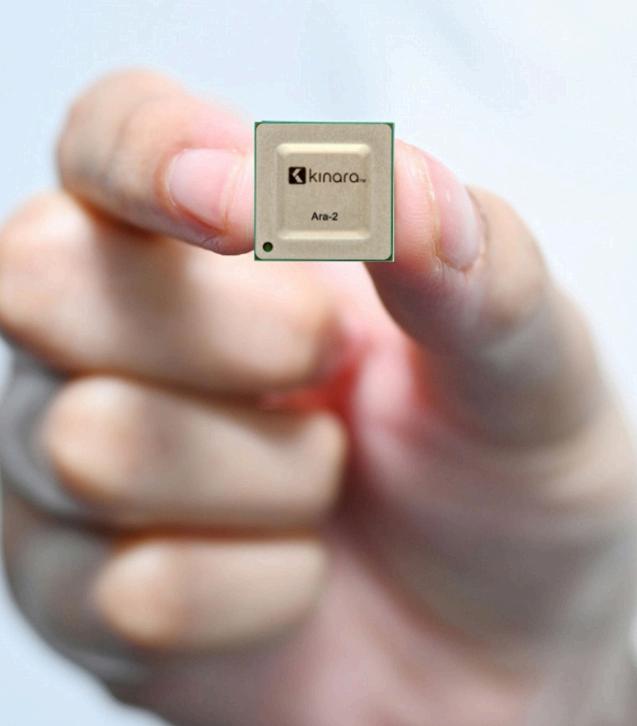
literally in the hands of the user.
Compared to the first generation processor, Ara-2 brings up to 5-8 times
SemiQon, a Finland-based startup specializing in silicon-based quantum processors, has announced it had successfully manufactured and pre-tested a 4-qubit quantum dot array from the first production run at its manufacturing facility in Espoo, Finland. The new chips are now shipping to strategic partners around the world as a toolkit for further research and development. The aim is to help make building stable logical qubits easier and faster to accelerate the use of quantum computing for complex problems.
First-generation quantum computers have already achieved impressive computational feats. However, solving highly specific problems related to pharmaceuticals, logistics, space, and material design will require increased computational power. As researchers, ecosystems, and companies around the globe lay out their ambitious visions for quantum computing, the computing power must still be scaled efficiently to address these challenges. Current methods do not make this possible.
- We are gradually moving towards the million qubit era and the contribution of hardware is becoming more and more essential, says Dr. Himadri Majumdar, CEO and Co-founder of SemiQon.
- Our solution builds on the technological development and know-how of semiconductors and benefits from existing infrastructure and industry. Utilizing such infrastructure effectively and efficiently has allowed us to accomplish one of our first goals within a short period of time. The challenge is getting to quantum supremacy in a sustainable, scalable, and affordable manner. These new chips are our first step in a long journey to making quantum dreams a reality, Majumdar concludes.
the performance. The processor comes with 10 billion parameters that are used by generative artificial intelligence models. Ara-2's software development platform (SDK) is specially designed to support high-precision quantization, dynamically moderated runtime, and direct FP32 computation.
According to Kinara CEO Ravi Annavajjhala, Ara-1 is the right solution for smart cameras and for processing 2-8 video streams at the edge of the network, while Ara-2 is perfect for processing 1632 video streams fed to edge servers and for laptops. especially the latter opens quite interesting expectations for the future of generative artificial intelligence.
According to Kinara, Ara-2 is able to produce images of text using Stable Diffusion software approximately once every half a second. No cloud computing can do this due to latencies.
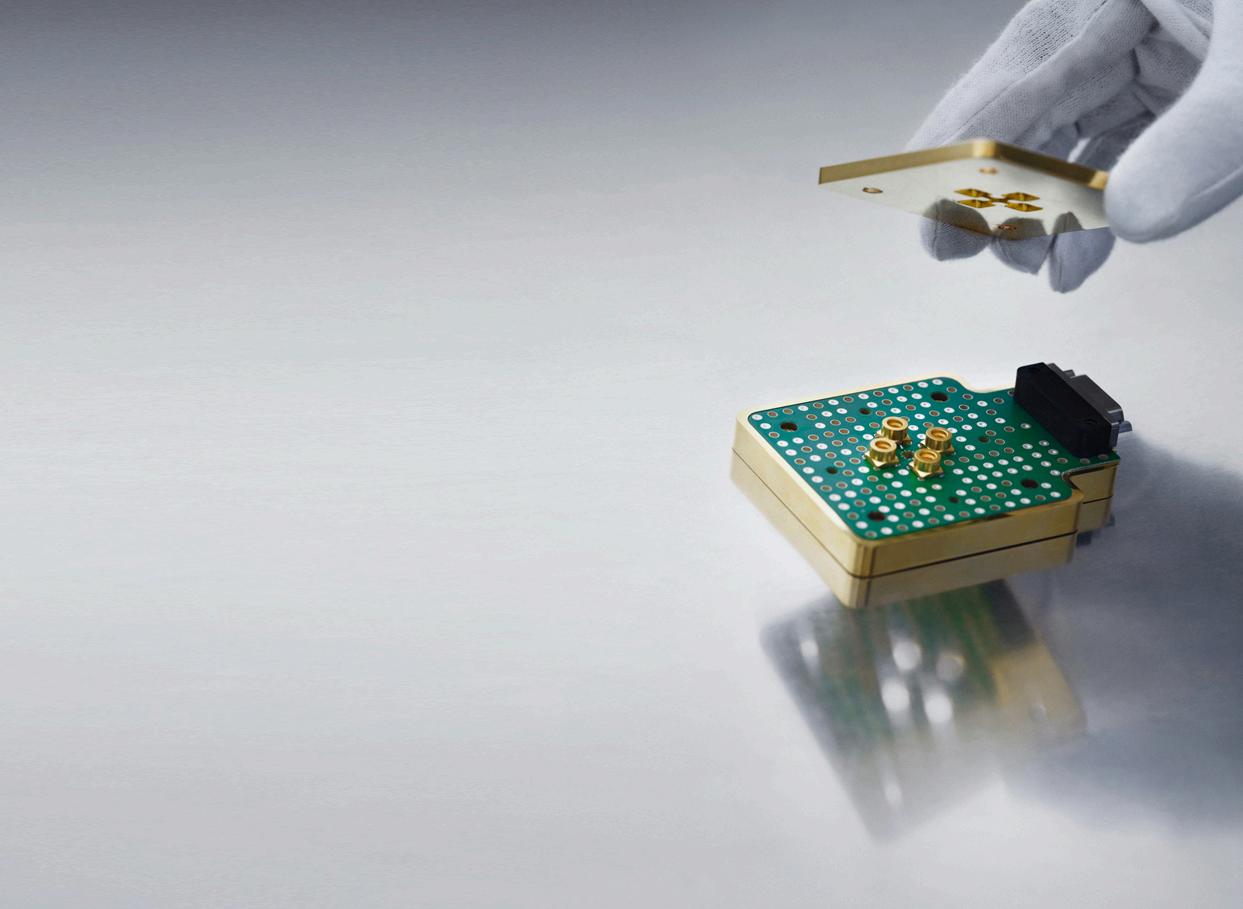
Soon there´ ll be autonomous vehicles on all kinds of roads. These need to be monitored all the time, so they do not cause collisions or accidents. The security of autonomous vehicles or robots cannot depend on the data connection.


A real-time data connection to the autonoous vehicle is not required from the remote monitoring station. Some manufacturers have full readiness for the highest level of automation, but the data transfer speed of network connections does not support it.
Now the moving device or a trolley is allowed to buffer data, store the control data it needs, but the condition is that it must stay inside the borders of its domain or operating area.
The regulation of the Finnish Transport and Communications Agency Traficom, which entered into force at the beginning of the year, is expected to speed up the traffic of both registered and unregistered vehicles that operate automatically.
Autonomous car manufacturers and operators are disappointed of the fact that wireless mobile networks do not support the advertised data connection speeds. Latency always varies.
Data buffering in the memory of the driving data machine works. It always slows down the development of real-time two-way control systems. That is why new regulations and development programs are already being prepared in the EU.
LEVEL 5 IS POSSIBLE
- In the fall of this year, an EU project will start where we will develop two-way real-time data transfer, says Antti Nikkanen. He is the CEO of Trombia
Technologies Oy of Kuopio. The company developes road brushing automation systems.
Both road traffic robots and cars can make the leap to full automation, which on the SAE scale is called Level 5. - We are fundamentally ready for full automation, Nikkanen adds.
Unfortunately the latency falling to less than a second in data network transfer is only a dream. These transmission problems have been identified in the measurements of Finnish Transport and Communications Agency Traficom.
- Data transfer that works with 100% certainty has not yet been invented. In any case, the basic idea behind all traffic automation must be that the vehicle must be able to cope with its driving performance without constant data transmission and at the latest it must be able to put itself in a state that minimizes risks without dependence on anything external. Safety itself must not depend on the security of data transmission, says Jukka Juhola, a special expert of Traficom.
Juhola talks about security, which is achieved with data transfer caching functions.
- Of course there is always need for faster and more secure connections, but it is not necessary to regulate the data transfer technology very precisely, because the basic requirement of the vehicle's ability
to operate independently in critical situations is more important, Juhola adds.
This becomes evidet with automatic goods conveyors, which must be able to stop if the device is no longer within the technical operating range.
According to Juhola, manufacturers investing in automatic driving aim for the car to be able to operate independently most of the time. Data is transferred proactively.
- Critical situations do not require online data transfer and latency is allowed accordingly.
The design and movement speeds of light electric vehicles and light automatic goods transporters were defined by the order issued on January 1, 2024. It replaced the old order from 2021.
- The requirement for obtaining a test permit is the so-called minimum risk function, Juhola concludes.
Reijo Jälkö, leading expert at Traficom, points out that the agency is currently processing several licenses. Among those is a application from Remoted Oy, which operates autonomous buses. Remoted claims says that it has already achieved the full 100% automation level and there would no longer be a need for a safety driver in the trolley.


At this year’s Embedded World in Nuremberg Renesas Electronics introduced the RA0 microcontroller Series based on the Arm Cortex-M23 processor. The new devices offer the industry’s lowest overall power
The RA0 devices consume only 84.3µA/ MHz of current in active mode and only 0.82 mA in sleep mode. In addition, Renesas offers a Software Standby mode in the new MCUs that reduces power consumption by a further 99 percent to a miniscule 0.2 µA. Coupled with a fast wake-up High-speed On-Chip Oscillator (HOCO), these ultra-low power MCUs deliver an ideal solution for applications including battery-operated consumer electronics devices, small appliances, industrial system control, and building automation applications.
OPTIMIZED FOR LOW COST
Renesas is now shipping the first group in the RA0 Series, the RA0E1 Group. These devices have a feature set optimized for cost-sensitive applications. They offer a wide operating voltage range of 1.6V to 5.5V so customers don’t need a level shifter/regulator in 5V systems. The RA0 MCUs also integrate timers, serial communications, analog functions, safety functions and HMI functionality to reduce customer BOM cost. A wide range of packaging options is also available,
including a tiny 3mm x 3mm 16-lead QFN.
In addition, the new MCU’s high-precision (±1.0%) on-chip oscillator (HOCO) improves baud rate accuracy and enables designers to forego a standalone oscillator. Unlike other HOCOs, it maintains this precision in environments from -40°C to 105°C. This wide temperature range enables customers to avoid costly and time-consuming “trimming,” even after the reflow process.
The RA0E1 MCUs include critical diagnostic safety functions as well as an IEC60730 self-test library. They also offer security features including true random number generator (TRNG) and AES libraries for IoT applications, including encryption.
The new RA0E1 Group MCUs are supported by Renesas’ Flexible Software Package (FSP). The FSP enables faster application development by providing all the infrastructure software needed, including multiple RTOS, BSP, peripheral drivers, middleware, connectivity,
networking, and security stacks as well as reference software to build complex AI, motor control and cloud solutions. It allows customers to integrate their own legacy code and choice of RTOS with FSP, thus providing full flexibility in application development. Using the FSP will ease migration of RA0E1 designs to larger RA devices if customers wish to do so.
Renesas has combined the new RA0E1 Group MCUs with numerous compatible devices from its portfolio to offer a wide array of Winning Combinations, including the HVAC Environment Monitor Module for Public Buildings. Winning Combinations are technically vetted system architectures from mutually compatible devices that work together seamlessly to bring an optimized, low-risk design for faster time to market.
The RA0E1 Group MCUs are available now, along with the FSP software and the RA0E1 Fast Prototyping Board. Samples and kits can be ordered either on the Renesas website or through distributors. More information here.
64-bitmicroprocessors withNeuralProcessingUnit builtforspeed,securityandreliability

STM32MP2serieselevatesindustrialcapabilities withaperformancesurgeandrobustresilience, engineeredforcritical,time-sensitivetasks, AI-drivenprocesses,andsecurecommunications, ensuringadecadeofreliable,uninterruptedservice.


With the rise of generative AI, the data utilized by companies has come into the spotlight. Simultaneously, there arises a demand for future professionals to undertake the new tasks revolutionized by AI. Maybe it´s time to hire a Chief AI Officer, suggest Piia Hoffsten-Myllylä who is the country manager for Kyndryl in Finland.
We live in a data economy, and the significance of data is continually increasing in almost all organizations. Now, generative AI has underscored the importance of data even more.
The first step towards an organizational AI readiness is the organising data and creating a comprehensive data plan. Data quality directly affects the quality of insights generated from generative AI solutions. Hence, ensuring data accuracy and avoiding biases is crucial for all companies. A strong data foundation and data architecture improve the reliability and quality of information, driving better business results.
In order to use generative AI solutions responsibly, the focus needs to be on the models informing them. When designing new solutions, transparency of decisionmaking processes behind them and the type of data used for training Gen AI must be ensured.
An open architecture improves visibility and increases the reliability of businesscritical data. A smart solution allows for easy combination and integration of data. Data management and utilization are simplified. The goal should be to maintaining a ccomprehensive data view throughout its entire lifecycle.
The business opportunities created by AI and generative AI have awakened Finnish companies. According to a recent survey by the Confederation of Finnish Industries (EK), less than half of Finnish companies are using AI.
Nevertheless, the majority see it as a significant driver of growth for business. The larger the company, the greater the importance of AI for business
development. According to the survey, 42% of the respondents are planning investments in AI solutions.
Now, organizations are actively testing and piloting generative AI solutions. New, better application areas are constantly emerging. AI is improving efficiency, productivity, and innovation in various industries. For instance, companies benefit from AI-assisted process automation, data analysis, and optimization of decision-making processes. Moreover, the employee and customer experience improve.
Right now, employee training is crucial. The potential of generative AI is not realized if the technology is not widely used across different workflows. Training helps to use tools effectively and supports the responsible use of AI.
As technology investments and the importance of data grow, companies will need experts and trusted partners who can interpret data contextually. The role Chief AI Officer (CAIO) is also becoming a reality in Finnish organizations. The CAIO is responsible for managing the company's data and ensuring that AI and generative AI solutions support the business objectives.
Reliable partners are essential on the organization's journey towards AI readiness. A good partner can help design and implement solutions that align with the organization's goal while also developing its future IT infrastructure.
Everything doesn't have to be ready all at once. The AI journey is well underway when use cases that align to business goals have been identified, and there is a strong forward-looking momentum.


 Shingo Kojima Renesas Electronics
Shingo Kojima Renesas Electronics
Renesas has developed the RZ/V2H, a unique AI processor that combines the low power and flexibility required by endpoints. It has the processing power for pruning AI models, and it is also 10 times more power efficient than the previous products.
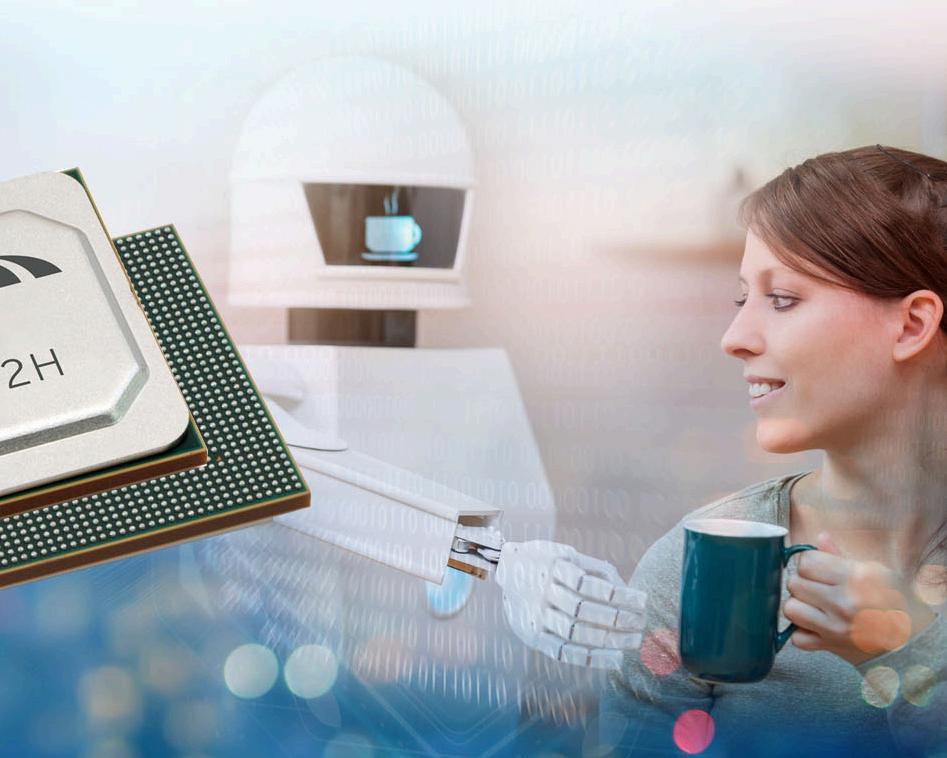
As the working population decreases due to falling birthrates and a growing proportion of the population being elderly, advanced artificial intelligence (AI) processing, such as recognition of the surrounding environment, decision of actions, and motion control, will be required in various aspects of society, including factories, logistics, medical care, service robots operating in the city, and security cameras. Systems will need to handle advanced artificial intelligence (AI) processing in real time in various types of programs. In particular, the system must be embedded within the device to enable a quick response to its constantly changing environment. AI chips need to consume less power while performing advanced AI processing in embedded devices with strict limitations on heat generation.
To meet these market needs, Renesas developed DRP-AI3 (Dynamically Reconfigurable Processor for AI3) as an AI accelerator for high-speed AI inference processing combining low power and flexibility required by the edge devices. This reconfigurable AI accelerator processor technology, cultivated over many years, is embedded in the RZ/V series of MPUs targeted at AI applications.
The RZ/V2H is able to respond to the further evolution of AI and the sophisticated requirements of these applications. This article introduces how the RZ/V2H solves heat generation challenges, enables high real-time processing speed, and realizes higher performance and lower power consumption for AI-equipped products.
RZ/V2H is a new high-end product of the RZ/V series, achieving power efficiency approximately 10 times higher than that of the previous products. The RZ/V2H is able to respond to the further evolution of AI and the sophisticated requirements of applications such as robots. This article introduces how the RZ/V2H solves heat generation challenges, enables high realtime processing speed, and realizes higher performance and lower power consumption for AI-equipped products.
As a typical technology for improving AI processing efficiency, pruning is available to omit calculations that do not significantly affect recognition accuracy. However, it is common that calculations that do not affect recognition accuracy randomly exist in AI
achieve both high recognition accuracy and an efficient pruning rate, and applied it to the DRP-AI3 design. In addition, software was developed to reduce the weight of AI models optimized for this DRP-AI3. This software converts the random pruning model configuration into highly efficient parallel computing, resulting in higher-speed AI processing. In particular, Renesas' highly flexible pruning support technology (flexible N:M pruning technology), which can dynamically change the number of cycles in response to changes in the local pruning rate in AI models, allows for fine control of the pruning rate according to the power consumption, operating speed, and recognition accuracy required by users.
Heterogeneous Architecture Features in which DRP-AI3, DRP, and CPUs Operate Cooperatively
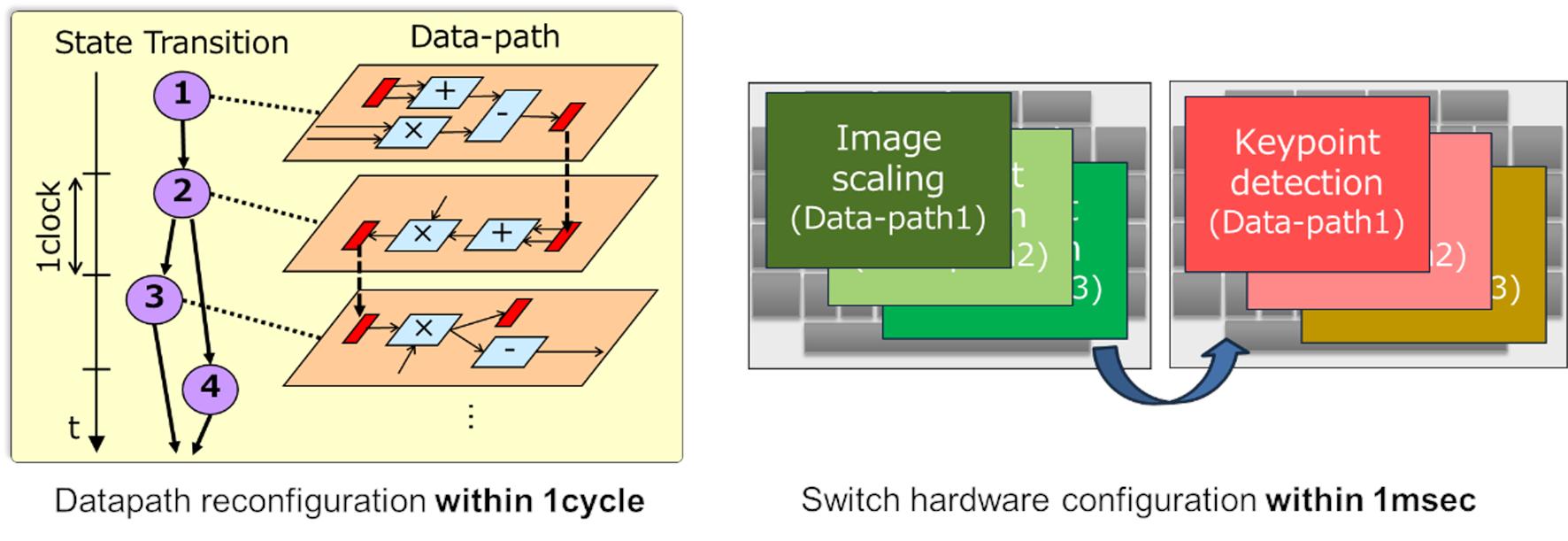
models. This causes a difference between the parallelism of hardware processing and the randomness of pruning, which makes processing inefficient.
To solve this issue, Renesas optimized its unique DRP-based AI accelerator (DRP-AI) for pruning. By analyzing how pruning pattern characteristics and a pruning method are related to recognition accuracy in typical image recognition AI models (CNN models), we identified the hardware structure of an AI accelerator that can
• Multi-threaded and pipelined processing with AI accelerator(DRP-AI3), DRP, and CPUs
• Low jitter and high speed robot applications with DRP (dynamically reconfigurable wired logic hardware)
Service robots, for example, require advanced AI processing to recognize the surrounding environment. On the other hand, algorithmbased processing that does not use AI is also required for deciding and controlling the robot's behavior. However, current embedded
Figure 1: Flexible Dynamically Reconfigurable Processor (DRP) Features.
Heterogeneous Architecture Configuration.
processors (CPUs) lack sufficient resources to perform these various types of processing in real time. Renesas solved this problem by developing a heterogeneous architecture technology that enables the dynamically reconfigurable processor (DRP), AI accelerator (DRP-AI3), and CPU to work together.
As shown in Figure 1, the dynamically reconfigurable processor (DRP) can execute applications while dynamically switching the circuit connection configuration of the arithmetic units on the chip at each operating clock according to the content to be processed. Since only the necessary arithmetic circuits are used, the DRP consumes less power than with CPU processing and can achieve higher speed.
Furthermore, compared to CPUs, where frequent external memory accesses due to cache misses and other causes will degrade performance, the DRP can build the necessary data paths in hardware ahead of time, resulting in less performance degradation and less variation in operating speed (jitter) due to memory accesses.
The DRP also has a dynamic reconfigurable function that switches the circuit connection information each time the algorithm
changes, enabling processing with limited hardware resources, even in robotic applications that require processing of multiple algorithms.
The DRP is particularly effective in processing streaming data such as image recognition, where parallelization and pipelining directly improve performance. On the other hand, programs such as robot behavior decision and control require processing while changing conditions and processing details in response to changes in the surrounding environment. CPU software processing may be more suitable for this than hardware processing such as in the DRP. It is important to distribute processing to the right places and to operate in a coordinated manner. Renesas’ a heterogeneous architecture technology allows the DRP and CPU to work together.
An overview of the MPU and AI accelerator (DRP-AI3) architecture is shown in Figure 2. Robotic applications use a sophisticated combination of AI-based image recognition and non-AI decision and control algorithms. Therefore, a configuration with a DRP for AI processing (DRP-AI3) and a DRP for non-AI algorithms will significantly increase the throughput of the robotic application.
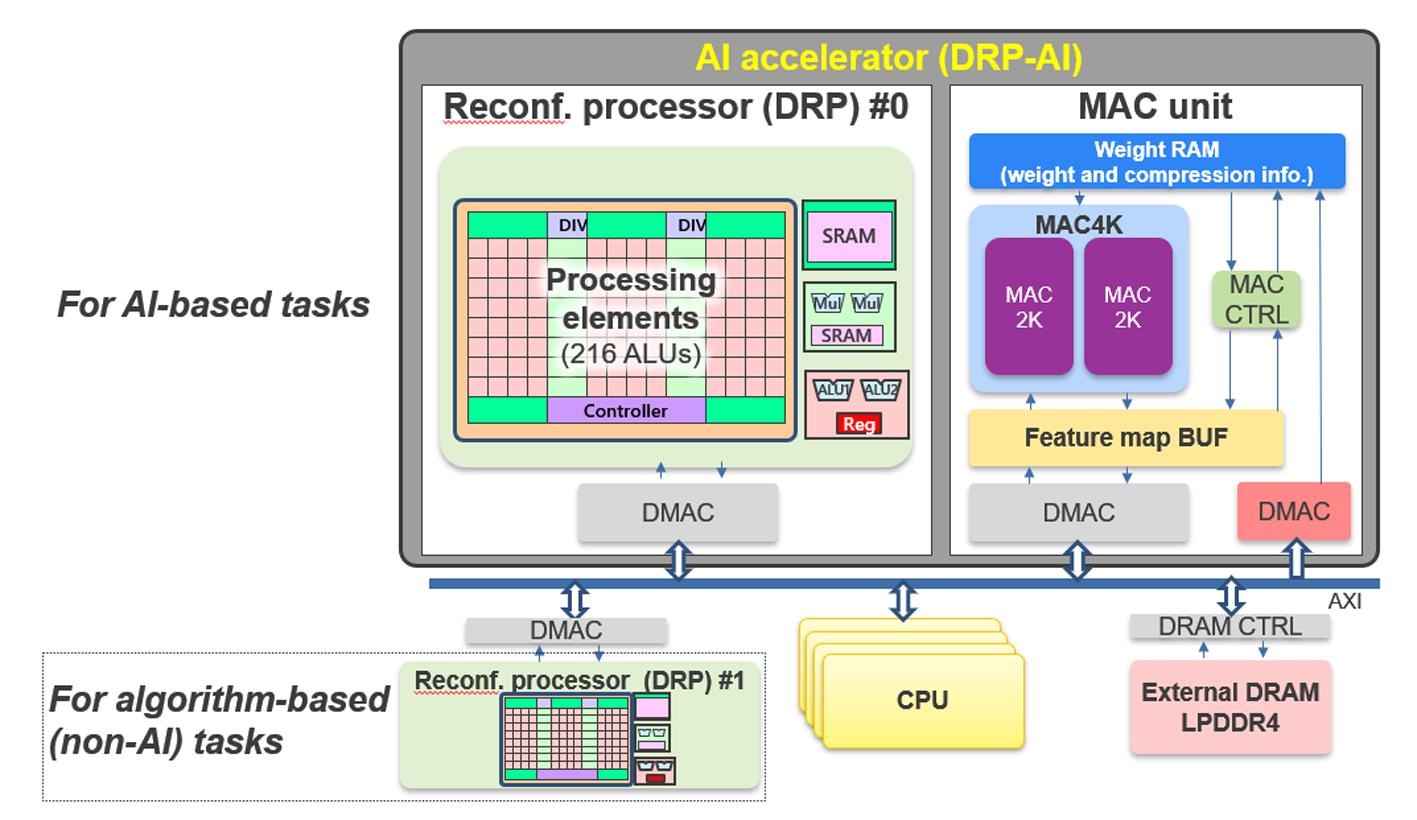
RZ/V2H equipped with this technology has achieved a maximum of 8 TOPS (8 trillion sum-of-products operations per second) for the processing performance of the AI accelerator. Furthermore, for AI models that have been pruned, the number of operation cycles can be reduced in proportion to the amount of pruning, thus achieving AI model
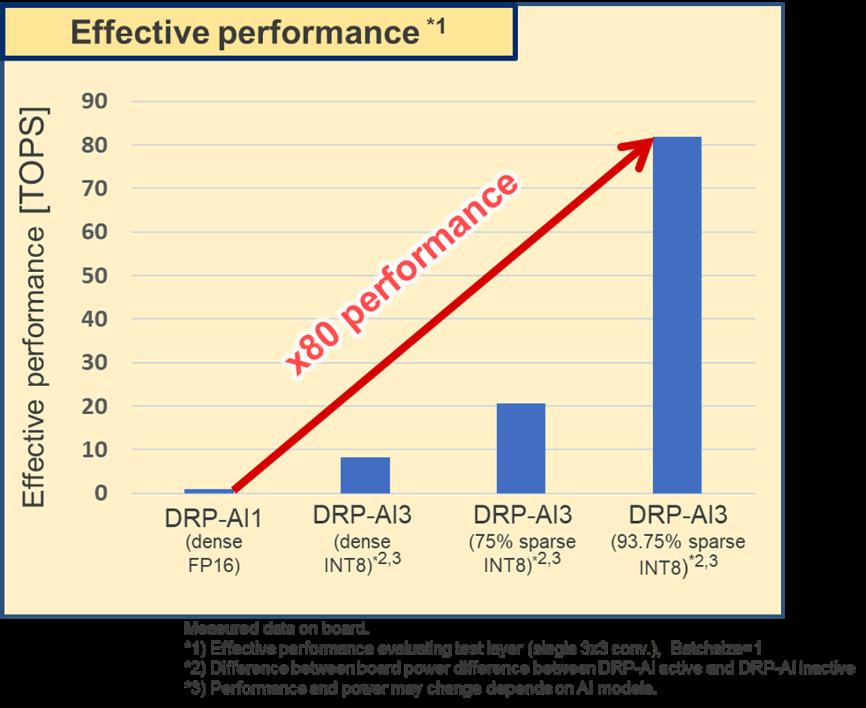
Figure 3: Comparison of Measured Peak Performance of DRP-AI3.
processing performance equivalent to a maximum of 80 TOPS when compared to models before pruning. This is about 80 times higher than the processing performance of the previous RZ/V products, a significant performance improvement that can sufficiently keep pace with the rapid evolution of AI (Figure 3).
On the one hand, as AI processing speeds up, the processing time for algorithm-based image processing without AI, such as preand post-AI processing is becoming a relative bottleneck. In AI-MPUs, a portion of the image processing program is offloaded to the DRP, thereby contributing to the improvement of the overall system processing time. (Figure 4)
In terms of power efficiency, the performance evaluation of the AI accelerator demonstrated the world's top level power efficiency (approximately 10 TOPS per watt) when running major AI models. (Figure 5)
We also showed that the same AI real-time processing could be performed on an evaluation board equipped with the RZ/V2H, without a fan at temperatures comparable to competitor products equipped with fans. (Figure 6)
For example, SLAM (Simultaneously Localization And Mapping), one of the typical robot applications, has a complex configuration that requires multiple program processes for robot position recognition in parallel with environment recognition by AI processing. The Renesas DRP enables the robot to switch programs instantaneously, and parallel operation with an AI accelerator and CPU has proven to be about 17 times faster than CPU operation alone, and to

Figure 4: Heterogeneous Architecture Speeds Up Image Recognition Processing (Measured by Test Chip).
Figure 5: Power Efficiency of Real AI Models (Measured by Test Chip).

reduce power consumption to 1/12 the level of CPU operation alone.
Renesas developed RZ/V2H, a unique AI processor that combines the low power and flexibility required by endpoints, with processing capabilities for pruning AI
models, and 10 times more power efficient (10 TOPS/W) than the previous products.
Renesas will release products in a timely manner responding to the AI evolution, which is expected to become increasingly sophisticated, and will contribute to deploy systems that respond to end-point products in a smart and real-time manner.
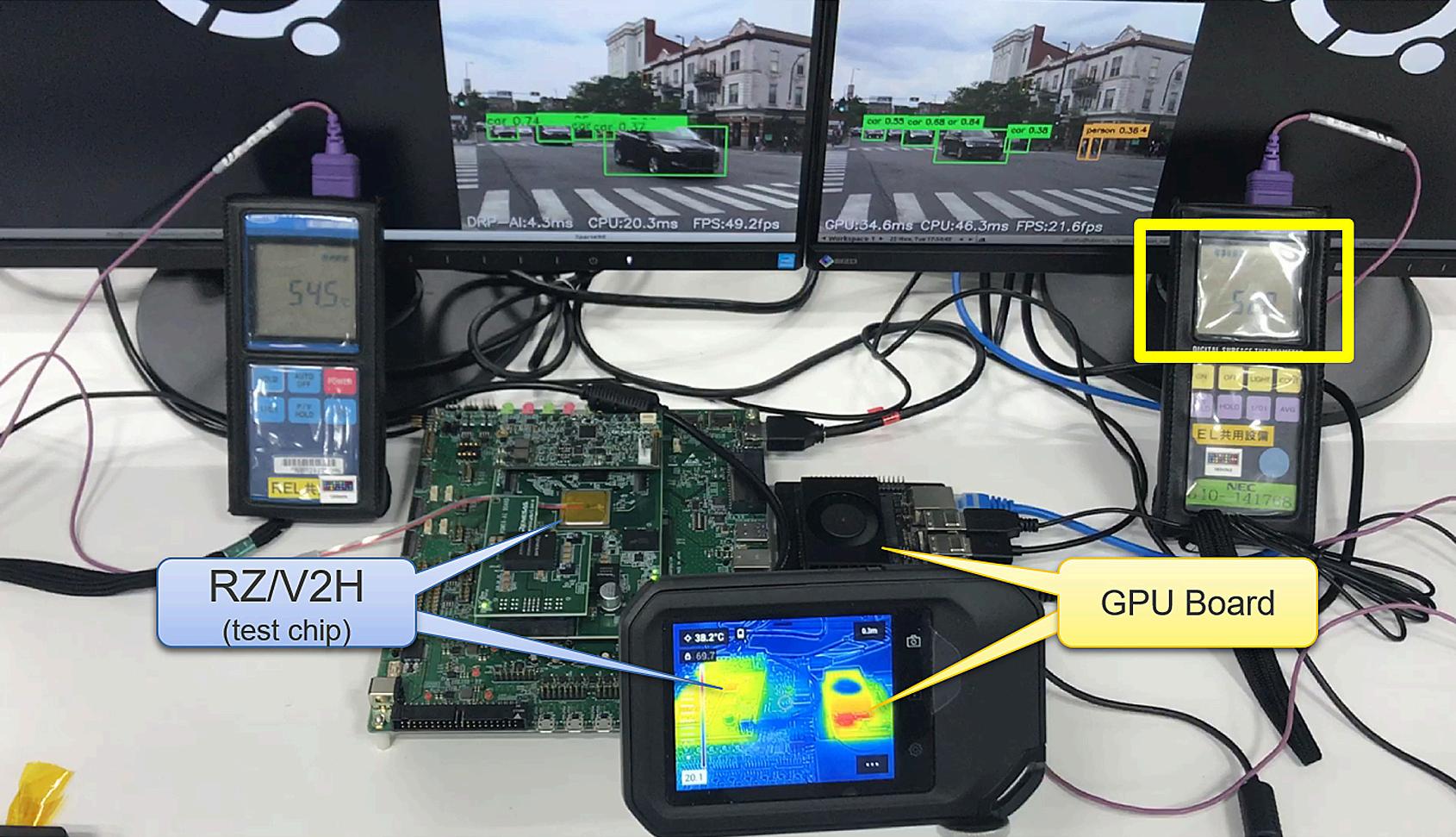
Figure 6: Comparison of Heat Generation between a Fanless RZ/ V2H Board and a GPU with Fan.
MORE INFORMATION • RZ/V2H • DRP-AI: Renesas' proprietary AI accelerator that combines high AI inference performance with low power consumption
 Baljit Chandhoke Microchip Technology
Baljit Chandhoke Microchip Technology

RF systems need power amplifiers (PAs) to deliver linear efficient high output power. As systems move to higher-order modulation schemes such as 64/128/256 Quadrature Amplitude Modulation (QAM), they also must deliver high linearity and efficiency in denser environments with stringent peak-to-average power ratio.
A new generation of Gallium Nitride (GaN)on Silicon Carbide (SiC) Monolithic Microwave Integrated Circuits (MMIC) PAs offers a solution to these challenges with the highest power density to generate high linear output power with high efficiency. This article goes into the requirements of 5G, satellite communications, aerospace and defense applications including the different types of beamforming architectures and how GaN on
SiC Power Amplifiers are solving the communication challenges in these RF applications.
PA
The biggest growth opportunities and challenges for the RF power amplifiers are in satellite communications, as well as emerging 5G communications solutions.
NASA has enabled private-sector companies to launch thousands of low-Earth-orbit (LEO) satellites that are now circling the earth and delivering broadband Internet access, navigation, maritime surveillance, remote sensing and other services. These RF applications consistently seek Size, Weight, Power and Cost (SWaP-C) benefits. Large dish antennas are being replaced with phased array antennas for satellite communication that require smaller size components for integration, as well as lower weight components. High RF power, which is linear with high P1dB and IP3, to reduce distortion and is efficient with high PAE to minimize power consumption, is essential for these RF applications.
New generations of millimeter-wave 5G communication solutions, by virtue of their speed, ultra-wide bandwidth and low latency for broadband communication, is substantially increasing how much information can be shared in support of realtime decision-making and other military applications. 5G systems operating in lower frequency bands (sub 6 GHz) have been vulnerable to high-power jamming signals, but 5G millimeterwave (24 GHz and above) systems are bringing 5G networking to both on-battlefield and off-battlefield applications with the millimeter wave band that is not as vulnerable to high-power jamming signals. Examples include battlefield sensor networks for
command-and-control data gathering, and augmented reality displays that enhance situational awareness for pilots and infantry soldiers. 5G will also enable virtual reality solutions for remote vehicle operation in air, land and sea missions. Off the battlefield, 5G will enable a variety of smartwarehouse, telemedicine and troop-transportation applications.
Different countries have different bands for 5G mmWave. In the United States, 28 GHz was the first 5G mmWave band deployed, which is being followed by 39 GHz. China is deploying 5G mmWave in the 24.25 – 27.5 GHz and have lagged in the adoption of the 5G mmWave.
5G network is composed of macro base stations and small cells. Macro base station is connected to the core network using mmWave Back haul or fiber optic links. Macro Base stations can talk directly to the user equipment cell phones or can talk to the small cells which talk to the user equipment mobile device providing the last mile connectivity. There are pico cells and femto cells which provide network connectivity inside office buildings where the connection might be weak or which have high user density.
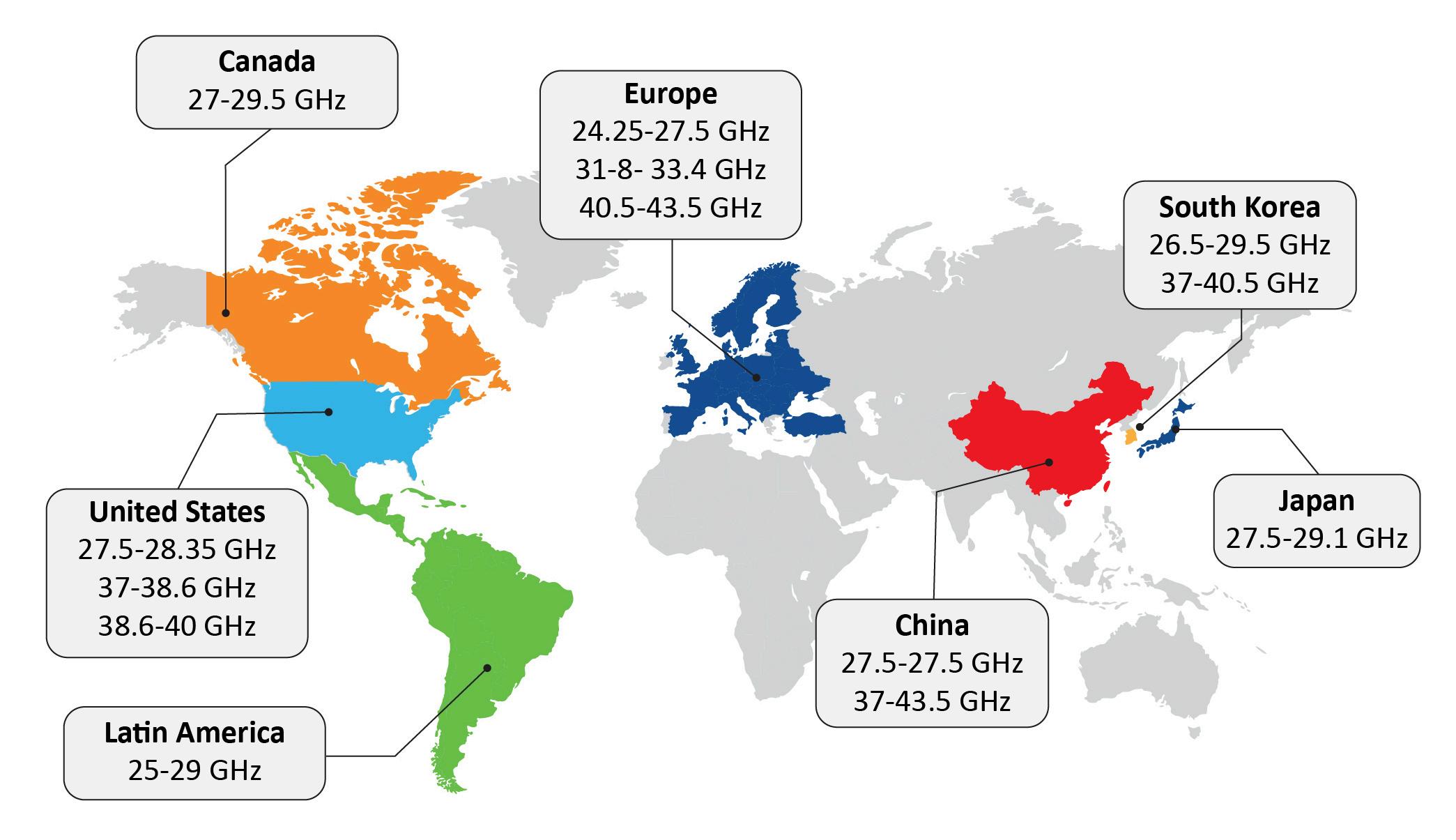
5G mmWave Frequency Bands
Globally.


5G Network Architecture Comprising of Small Cells and Macro Base Station.
Femtocellsare typically user-installed to improve coverage area within a small vicinity, such as a home office or a dead zone within a building. Femtocells are designed to support only a handful of users and are only capable of handling a few simultaneous calls – they have a very low output power up to 0.2Watts
Picocellsoffer greater capacities and coverage areas, supporting up to 100 users over a range up to 300 metres. Picocells are frequently deployed indoors to improve poor wireless and cellular coverage within a building, such as an office floor or retail space. Picocells can be deployed temporarily in anticipation of high traffic within a limited area, such as a sporting event, but are also installed as a permanent feature of mobile cellular networks in a heterogeneous network working in conjunction with Macro cells to provide uninterrupted coverage for end users. They have an output power up to 2 Watts.
Macro base stations – are large base stations covering a large area > km and have output power of up to > 100 Watts.
Radar systems operate in the 1 Gigahertz (GHz) to 2 GHz L band for applications including “identify friend or foe,” distance-measuring equipment, and tracking and surveillance. S band (2 GHz to 4 GHz) is used for selective response Mode S applications and for weather radar systems. X Band (8 GHz to 12 GHz) is used for weather and aircraft radar, while C Band (4 GHz to 8 GHz) is used for 5G and other sub- 7 GHz communications applications. 5G mmWave provides the highest bandwidths and data rates, operating in 24 GHz and higher frequency bands. Satellite communications for LEO and geosynchronous communication operate in the K band, which spans from 12 GHz to 40 GHz.
Different types of Phased Array Beamforming architectures used in these RF applications are:
1. Analog Beamforming
2. Digital Beamforming and 3. Hybrid Beamforming
Marine Radar communicati on uses frequencies in the Sband, L-band, C-Band, XBand all the way up to Ku/Ka band.
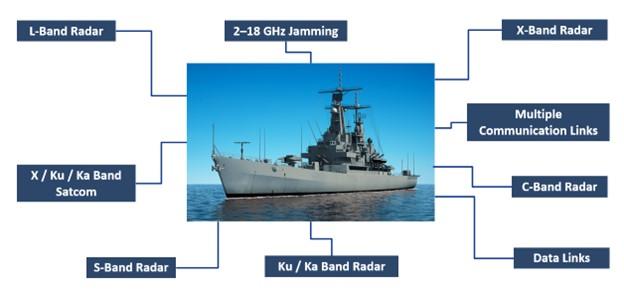
For any Phased Array, the ideal separation between elements is wavelength lambda/ by 2.
The block diagram shows Analog Beamforming: There are four Phased Array elements separated by wavelength Lambda by 2. For a 30 GHz signal, it will be 5 mm separation between Phased Array elements. In Analog beam forming, the phase shifter does the beam forming by changing phase to do constructive interference for receiving and transmitting the signal by focusing the energy from the beam in a particular direction.

Block Diagram of Analog Beamforming with Four Phased Array Elements.
This is all done at RF Frequency hence is most sensitive to interconnect losses. Then the signal from the phase shifter goes to the power combiner/ splitter, followed by up down converter and ADC/DAC to the base band. In this case there is for N Phased Array elements there is only one Digital Front end.
As seen in the block diagram, for 4 Phased Array elements, there is only one digital front end comprising of ADC/DAC. The benefit of this architecture is the smallest number of components, lowest power dissipation. However, as the phase shifting is done in RF bands – this type of beamforming architecture is most sensitive to interconnect losses and complexity in phase shifting.
Digital Beamforming has traditional up down conversion to the baseband band frequency and then digital phase shifting is done. This
architecture provides more precision as digital beamforming is done in the baseband. However, there is ADC/DAC for each phased
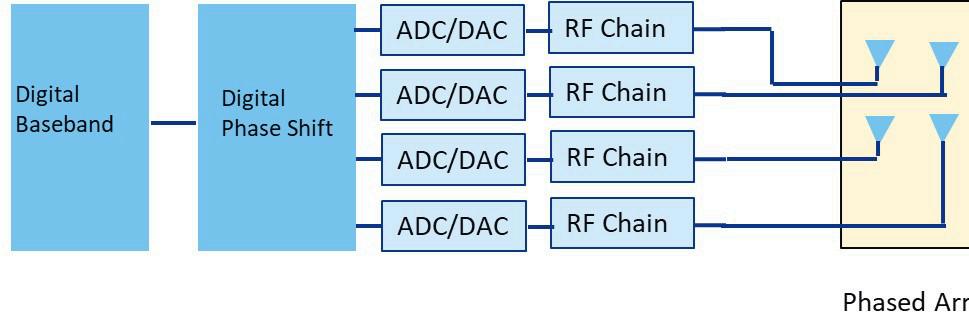
Block Diagram of Digital Beamforming with 4 Phased Array Elements.
array element resulting in large number of components and high-power dissipation. In this case for N Phased Array elements there are N Digital Front ends. As seen in the block diagram, for 4 Phased Array elements, there are 4 digital front ends comprising of ADC/ DACs.
Hybrid beamforming combining digital and analog beamforming is optimal for larger phased arrays to get the efficiency of analog beamforming with less number of elements, power dissipation and precision of digital beamforming. As seen in the block diagram,

Block Diagram of Hybrid Beamforming with 4 Phased Array Elements.
for 4 Phased Array elements, there are 2 digital front ends comprising of ADC/DAC. Comparing with Analog Beamforming there was only a single digital frontend ADC/DAC and with Digital beamforming there were 4 digital frontend ADC/DACs.
The figure shows the RF Signal chain block diagram. At the receiver, the RF signal comes in through the antenna, goes through a
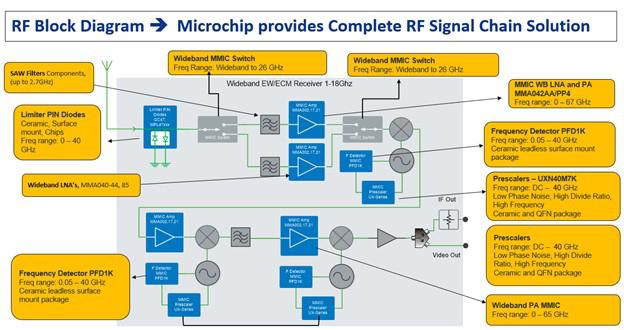
limiter diode, followed by a switch and the desired RF frequency is selected through the saw filters. The desired signal is then amplified through the low noise amplifier with extremely low noise figure to minimize degradation in signal to noise ratio of the received signal. Then, it is down converted using a mixer. The local oscillator (LO) signal is generated using discrete PLL components comprising of phase frequency detector, prescaler to provide the LO frequency to the Mixer to down convert the signal to Intermediate Frequency (IF), followed by conversion from IF to baseband for signal processing.
At the transmitter, the base-band signal is upconverted to IF and then to the desired RF frequency. The RF signal is amplified using a Power Amplifier to transmit the signal.

The table demonstrates the RF Figure of Merit and the benefits for components used in the RF Block diagram.
Power Amplifiers (PAs) play a key role at the transmitter in RF applications. One of the biggest PA requirements is that it can operate in its linear region to minimize RF distortion. Satellite communications systems that use higher-order modulation schemes such as 64/128/256 Quadrature Amplitude Modulation (QAM) are extremely sensitive to non-linear behavior. Another challenge is achieving satisfactory peak-to-average power ratio (PAPR)—that is, the ratio of the highest power the PA will produce to its average power. PAPR determines how much data can be sent and is proportional to the average power. At the same time, the size of the PA needed for a given format depends on the peak power. 5G mmWave Effective Isotropic Radiated Power (EIRP) requirements mandated by FCC include 43dBm EIRP transmit power for the Mobile handsets and Base Station Transportable Power of 55dBm EIRP. These and other conflicting challenges can only be met with GaN on SiC power amplifiers for satellite communication, 5G, aerospace and defense applications.
GaN on SiC has the highest power density to generate high linear output power with high efficiency. GaN on SiC power amplifiers can
RF Signal Chain Block Diagram.

ICP2840 Linear PAE Across Frequency and Output Power Levels.
operate at high frequencies in the Ka, Ku band from 12 GHz to 40 GHz for satellite communication, 5G and have broad bandwidths, high gain with better thermal properties, meeting the requirements of RF applications. Microchip provides RF solutions using GaN on SiC technology meeting the SWaP-C requirement for components.
ICP2840 is a flagship device which operates in 27.5–31 GHz providing continuous wave (CW) output power of 9 watts and pulsed output power of 10 watts with a gain of 22 dB and power added efficiency of 22%.
ICP2840 generates 9W continuous wave output power in the Ka band from 27.5–31 GHz for uplink frequency for satellite communication as well as 28 GHz 5G frequency band.

ICP2840 Linear Gain Across Frequency and Output Power Levels.
ICP2637 has a wide bandwidth from 23–30 GHz and generates 5 watts CW output power and is offered in a QFN package as well as in die form.
ICP1445 generates 35 watts pulsed output power in the 13–15.5 GHz frequency Band.
ICP1543 operates in the Ku band 12 to 18 GHz generating 20 watts CW output power.
These PAs have high gain and power added efficiency using GaN on SiC technology and meet the requirements at Ku/Ka band for 5G, satellite communication, aerospace and defense applications. GaN on SiC with its highest power density provides the optimal power amplifier solutions for these applications.


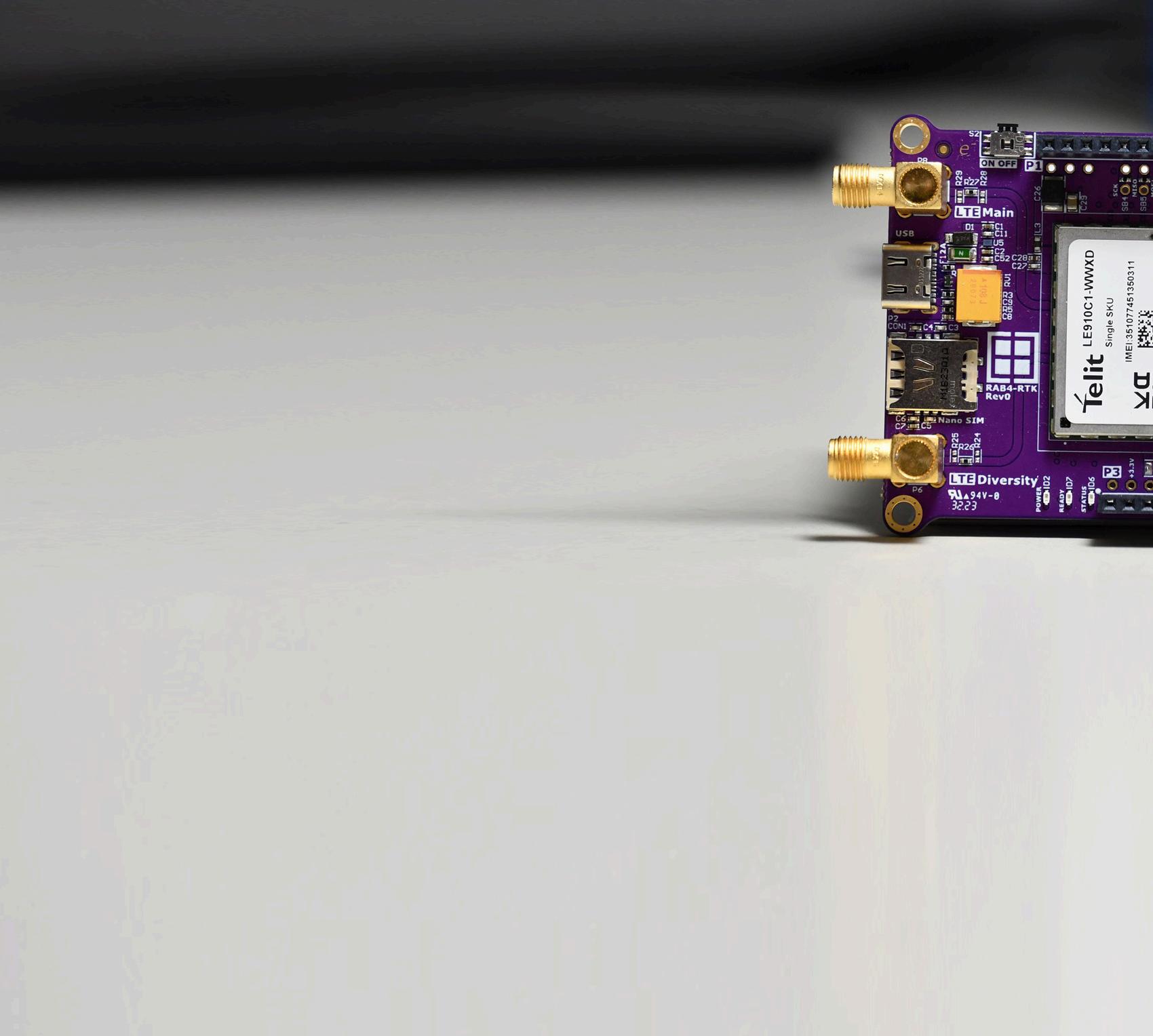 Stephan Menze Rutronik
Stephan Menze Rutronik
Inaccurate positioning is a potential source of error. However, some applications in the fields of agriculture, construction and surveying, geology and robotics as well as disaster control can only be realised if the corresponding precision is available. With Real-Time Kinematic (RTK), a technology is now becoming economically attractive that enables high-precision positioning down to approximately 2 cm in real time.
This type of positioning offers enormous potential for increasing efficiency and conserving resources, but is also an extremely complex technology. Together with the Wireless Competence Centre, Rutronik System Solutions has tackled this issue and created the RAB4, an adapter board for RTK applications that gives companies fast access to this pioneering technology.
Distributor Rutronik has been aware of the high relevance of real-time kinematics and its positive influence on target applications and markets such as AGVs, drones, robots and
smart farming for several years. The Rutronik Wireless Competence Centre not only offers the latest state-of-the-art solutions with products from Unicore Communication, but also individual product and system consulting, which also highlights antenna concepts, power supplies and the radio data transmission of correction values.
Rutronik can draw on the portfolio of around 250 other electronics suppliers and thus put together a complete GNSS system from a single source for each specific applicationfrom the Xeon high-performance server and cloud-based device management with optional geofencing rules to the status LED.
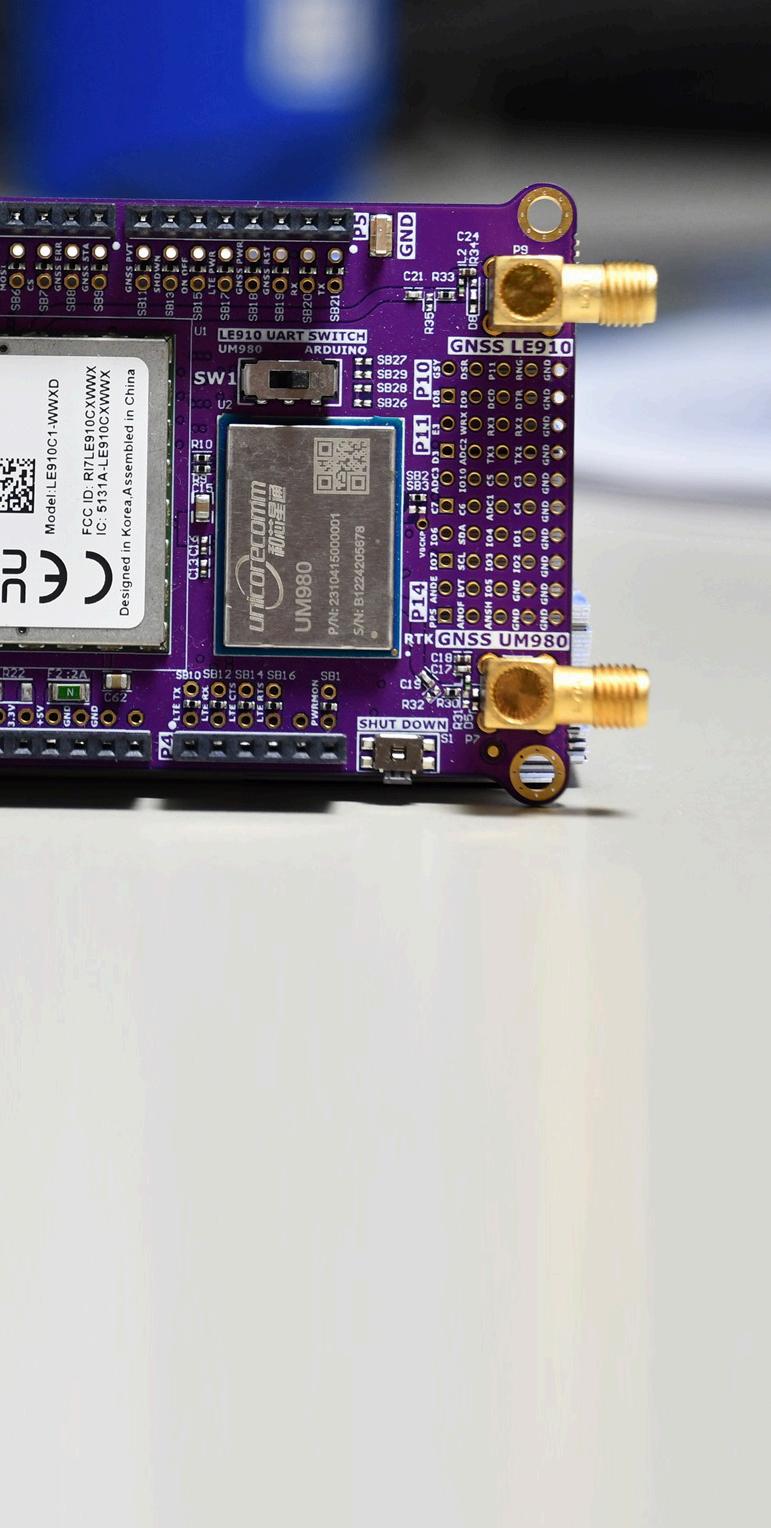
Rutronik System Solution has developed the RAB4 in close cooperation with the wireless division to help customers who could imagine an RTK solution for their applications but are hesitant about the complexity of a corresponding system. This is an adapter board that can be used to quickly test the performance of the technology without having to develop your own hardware. This reduces the time and costs involved in the pre-development phase and applications reach market maturity more quickly. Another advantage of the RAB4 is that it can be easily combined with other developer boards from Rutronik System Solutions such as the RDK3 thanks to the
Arduino interface. Coupled to the RDK3, for example, relative positioning is possible using a Bluetooth Low Energy connection.
The core elements of the RAB4 include the UM980 GNSS module from Unicore, a highprecision multi-constellation/multifrequency RTK positioning module based on the GNSS SoC NebulasIV. It supports all currently available constellations and frequencies (GPS/BDS/GLONASS/Galileo/ QZSS). With an RTK data update rate of 50 Hz, the module supports PPP including E6
HAS and BDS B2b. Instant RTK initialisation technology, 60 dB narrowband interference rejection and detection and Heading2 and highly accurate SA positioning technology ensure a stable and fast connection.
To fully and independently utilise the RTK technology, an internet connection is required, which is enabled by the second
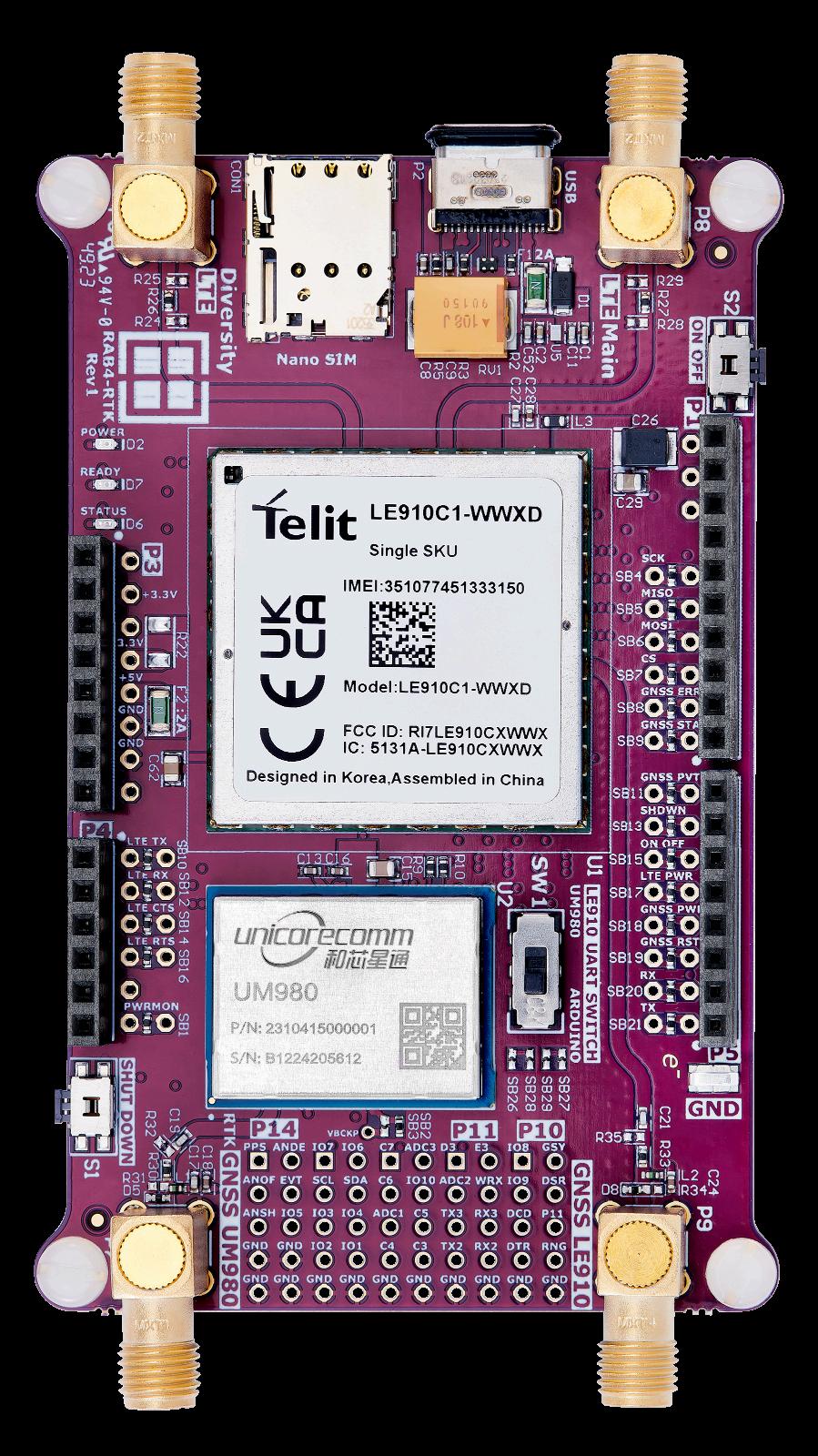
Front view of RAB4 board.

core element, the Telit Cinterion LTE C1 ThreadX GNSS module with 2G/3G fallback. This module offers a first-class 3GPP rel10 platform and is already designed for MTC functions according to 3GPP Rel.12. It allows easy integration with peripherals and actuators via USB 2.0 HS, UART and customisable GPIOs. The integrated TCP/IP and UDP/IP stacks ensure fast and uninterrupted data transmission.
The distributor even supplies its customers with the SIM card required for the integrated NanoSIM Card Connector from JAE (with 100 MB data volume), allowing
developers to put the board into operation immediately.
Three different antennas from 2J are preinstalled on the RAB4 in order to be able to test which model is actually relevant for the planned application during pre-development:
• Cellular 4G LTE/3G/2G MIMO Magnetic Mount Antenna (2J6924MA): Specially developed and tuned for wireless MIMO technology, the dual cable antenna is capable of transmitting and receiving more than one data signal simultaneously. With its IP67/IP69 protection rating, it is also suitable for applications in more robust environments, such as agricultural machinery.
• GPS/GNSS/SBAS/RTK/L1/L2 dome antenna with magnetic mounting (2J7C01MC2F): It impresses with its high precision and accuracy in the centimetre range thanks to the combination of Precise Point Positioning (PPP) L1 and L2 with RTK. This component is an ideal choice for land and hydrographic surveying applications in particular, as it uses real-time error correction while maintaining centimetre-accurate positioning data.
List of core components used in Rutronik´s RAB4 card.

• GPS/GLONASS/BeiDou/QZSS/Galileo/ IRNSS/L1/L5 Dome Antenna
(2J7C01MC3F): This model is also designed for high-precision and advanced signalling technologies and covers all major GNSS bands. The highperformance antenna impresses with its low power consumption (48 mW) and consistently high efficiency. Here too, the IP67/IP69 protection class enables use in demanding environments.
Until now, RTK was considered too complex and expensive to be used as an interesting alternative for positioning applications beyond niche markets such as agriculture. In the coming years, Rutronik sees a significant change in the choice of positioning technologies.
For example, RTK offers the possibility of ensuring the absolute positioning of e.g. agricultural machinery, AGVs or robots and
enables the realisation of completely new, (partially) automated applications. This aspect, combined with the positive price trend, makes it very likely that RTK will establish itself as the sole technology in the future markets of Smart City, Smart Gardening and Smart Agriculture.
Rutronik also expects RTK to largely replace previously used technologies in the automotive market segment within the next few years. Every centimetre plus or minus makes a difference, especially in the case of expanding smart city solutions, such as intelligent car park searches or the efficient coordination of emergency vehicles.
With the complete package of board and comprehensive documentation, Rutronik now offers interested customers extremely simplified access to this promising technology and enables the development of new market segments.
RTK uses two GNSS receivers for localisation: a base receiver and a rover receiver. The base receiver is in a fixed position and receives signals from satellites in order to obtain position information. These signals, or correction data, contain information about deviations from the expected value, for example due to atmospheric conditions. To do this, the base station calculates its own position using the signals received from GNSS satellites and compares them with its known, fixed position. Errors and deviations are recognised and a correction signal is generated, which is transmitted to the rover receiver in real time.
The rover is placed where the position is to be measured, e.g. in the vehicle. This means that it usually has a mobile rather than a fixed position. Both receivers communicate with each other via a wireless connection. In this way, the rover receives the correction data from the base receiver and can increase the accuracy of the position calculation.
Communication between the two receivers takes place via a base station, so that only an internet connection to it is required. The station with the strongest signal at the time of the enquiry is always selected.

One of the major trends in modern technology applications is machines that require awareness of their surroundings. This can be done with image sensors, but there are concerns in how they maintain privacy. Designers are looking to alternative technologies such as mmWave radar.

The use cases are very broad, encompassing everything from automotive to industrial, consumer, and more. Clearly, things that move (drones, automobiles, automated guided vehicles, domestic robots, to name just a few) need to be able to detect and react to obstacles and other vehicles, while static objects need to be aware of things in their vicinity. For example, buildings use presence detection to control energy usage,
and vehicle cabins are increasingly being monitored for safety reasons.
Some of this is being driven by the desire for sustainability. Detecting the presence of humans in a building allows lighting and other resources to be used only when it is truly necessary, saving valuable energy and reducing operating costs. Convenience is another driver, spurring the need for tasks
such as opening a door when a person is moving towards it.
In factories, robots are increasingly being incorporated into the workforce. This close co-operation between humans and robots brings many benefits in output but creates safety concerns. If a robot (static or mobile) can detect humans nearby, then movement can be restricted temporarily and safety can be enhanced.
In vehicles, knowing the number of occupants, where they are, and their approximate size and weight allows for the correct airbags to be deployed with appropriate force. This ensures that the deployment is beneficial during a sudden stop and does not injure the passengers. Euro NCAP1 is pushing vehicle occupant monitoring forward, especially in areas such as detecting the presence of children.
One of the most important components in presence detection is a sensor. Common technologies behind these sensors include converting light to electricity (e.g., image sensors), passive infrared, and mmWave radio band.
With the number of small, high-performance, high-resolution image sensors currently available, this seems to be a natural technology to use to detect obstacles in the environment, including the presence of humans. There are limitations to this technology—primarily the need for line-ofsight vision and the inability to identify a disguised human (e.g., a small child under a blanket in a vehicle)— but from a technical perspective, the performance is more than adequate.
However, the greatest drawback with image sensors lies in the privacy concerns that they generate. For most applications, it is only
necessary to detect that a human is present. Image sensors can detect which human is present – and then store that data for all time. So, to meet the need for presence detection and tracking without creating privacy concerns, designers are looking to alternative technologies such as mmWave radar.
For years, passive infrared (PIR) technology has been a popular method of detecting humans for applications such as automated lighting or security alarms. The PIR sensor detects a change in the infrared energy when a human moves into range and if a pre-set threshold is exceeded, the light is switched or alarm activated.
There are a few limitations with PIR technology, including a relatively short range that requires more sensors to be deployed. It struggles to detect humans that stand still or move very slowly and, if PIR is used outdoors, weather can render it almost useless. As it requires a direct line of sight, it is also very obtrusive.
Although more complex to implement, mmWave radar offers several advantages over PIR. Since it is based on the wellunderstood Doppler principle, it can detect motion as well as the speed and direction of an object. Also, because it does not require infrared energy, it can detect inanimate objects. The ability to detect speed and direction allows for more intelligent decisions to be made. For example, with mmWave, a door would only open if a person is walking towards it, not walking past it (Figure 1, p. 40).
The operating distance for mmWave ranges from a few centimetres to hundreds of
Figure 1: Automatic doors can be operated more intelligently with motion and direction detection (Source: Texas Instruments. Redrawn by Mouser Electronics).

metres, allowing full coverage with a single sensor in many applications. It can also operate through thin coverings such as plasterboard (drywall), meaning that it can be deployed unobtrusively within buildings.
In building automation, mmWave technology can enhance convenience and security as well as reduce operating costs through controlling facilities such as lighting, heating and air conditioning based upon the presence of people. Unlike image sensors, as mmWave does not capture video, it has no privacy concerns and can be used in sensitive areas such as toilets or changing areas.
Within the automotive sector, mmWave is proving to be a useful technology for incabin presence detection (CPD) within vehicles. Detecting visible humans and estimating their size is well within the capability of the technology and, with this data, airbags can be deployed only where needed and at an appropriate force, thereby ensuring passenger safety.
In-vehicle CPD is increasing in importance and many technologies can detect the presence of a visible child that has been left behind. However, the precision of mmWave technology, for example, even allows the detection of babies left under a blanket by detecting the motion due to breathing and / or the heartbeat.
Texas Instruments' mmWave sensors are used in automotive advanced driverassistance systems (ADAS) for long- and short-range applications, allowing the vehicle to be aware of its surroundings. The advanced CMOS single-chip sensors reduce design size by combining the RF front-end with a digital signal processor (DSP) and microcontroller (MCU), allowing for the detection of complex urban scenes and other road users.
The technology is also important in industrial applications, where it is used for detecting presence and liquid levels as well as guidance for warehouse robots and drones (Figure 2, p.41).
While the technology may be unfamiliar to some designers, there are several tools available aimed to ease the design process. The MM5D91-00 from Jorjin Technologies Inc. is a presence detection sensor module based upon 60GHz mmWave technology. The convenient device includes one transmit antenna, three receive antennas, and a powerful Arm Cortex-M4F processor system.
As is the case with many innovative technologies, mmWave radar is opening up new applications. For example, gesture recognition is replacing physical control panels with virtual human-machine interfaces (HMIs). Here, a person can place a
hand in front of the sensor and then move it in pre-defined patterns as an input to the system. Actions are often intuitive with a flat palm indicating ‘stop’ or the rotating of a hand to move a virtual dial, increasing or decreasing a parameter such as volume.
Gesture recognition offers a few benefits, depending on where and how it is used. In automotive applications, safety and convenience are the primary advantages as drivers do not have to find a small button
predicted 18.2% CAGR, which will value the market at US$3.25 billion by 2032.
Awareness of surroundings is key in allowing machines to have greater autonomy to move or recognise approaching hazards. While image sensors can be used for this, many people are concerned about the privacy aspects as humans can be identified and tracked.

while driving, allowing them to keep their eyes on the road. As there is no contact between the person and the HMI, it is also more hygienic—a benefit in healthcare and catering applications, among others.
With the increasing number of small devices coming onto the market, gesture recognition also helps designers reduce the space taken up by physical HMI buttons and dials. As the device is updated to add additional functionality, new gestures can also be added to keep pace.
The market for this technology is relatively new; Global Market Insights2 estimated that gesture recognition in the automotive sector alone was valued at US$644 million in 2022). The anticipated adoption and value of the technology is recognised by the
Alternative technologies, such as mmWave radar, can provide the necessary situational awareness while eliminating privacy issues as they do not record images of faces. In fact, unlike many image sensors, 60GHz mmWave radar can operate over distances of less than 100m and in poor weather conditions, making it a preferred solution for many designers.
1 - https://www.euroncap.com/en/ vehicle-safety/the-ratings-explained/safety-assist/occupantstatus-monitoring/
2 - https://www.gminsights.com/ industry-analysis/automotivegesture-recognition-market
Figure 2: mmWave technology has multiple applications within the industrial sector (Source: Mouser Electronics).
 An
An
STMicroelectronics and Amazon Web Services have joined forces to create a machine-learning application for audio event detection that LACROIX, a member of theST Partner Program, is looking to use in smart cities. The combination of ST and AWS technologies opens new possibilities for creation of machine-learning applications at the edge.
The solution uses an Audio Event Detection model found in the ST Model Zoo deployed on a Discovery kit for IoT node with the STM32U5 microcontroller series.To ensure seamless cloud connectivity, it utilizes an extension pack that integrates FreeRTOS withAWS IoT Core and the architecture supports the entire MLOps process. Indeed, the machine-learning stack is responsible for data processing, model training, and evaluation, while the IoT stack handles automatic device flashing with OTA updates. It
ensures that all devices are running the latest firmware security patches.
The pipeline stack manages the orchestration of the CI/CD (Continuous Integration / Continuous Delivery) workflow. This is a critical concept in development and operations (DevOps) as it ensures developers always update their work, optimize their code, and improve their applications.When working with neural networks, the ability to tweak a system to
improve its accuracy is paramount. Consequently, developers automate the deployment of the ML and IoT stacks as they manage the entire development lifecycle of their solution.
Finally, for device monitoring and data visualization, Amazon Grafana was used to create dynamic and interactive dashboards for real-time monitoring and analysis. Since ST launched its STM32Cube.AI in 2019, the industry is clearly moving toward greater adoption of AI on microcontrollers for all sorts of applications.In this instance, developers use a version of the Yamnet audio classification model optimized for the STM32 MCUs to run an audio event detection program.After training the neural network, the system can distinguish between a wide range of noises, from dogs barking to someone shouting, sound of a car crash, and many more.
What did it take to make it happen today?
Even before delving into the machinelearning aspect of the solution, the fact that ST released the X-CUBE-AWS extension pack was one of the reasons that brought AWS to work with the STM32U5 IoT Discovery Kit. Indeed, the software package contains a reference integration of FreeRTOS™ with AWS IoT that easily and securely connects to the AWS cloud. Developers can thus spend time on the AI itself rather than figure out how to manage the secure connectivity to a
remote server. ST even provides a reference implementation based on STM32Cube tools and software, which will further simplify IoT designs leveraging the rest of the STM32 ecosystem.
The STM32 AI Model Zoo and STM32 Board Farm are two features launched with the STM32Cube.AI Developer Cloud.Indeed, by using the audio model from the ST Model Zoo, developers already benefit from an optimized algorithm.Teams working on a final product will further prune their neural network and increase performance. However, when trying to gauge their needs, perform a feasibility study on a microcontroller, or come up with a proof-of-concept, engineers can trust the version in ST Model Zoo will run efficiently on STM32 devices.
The STM32 Board Farm, accessible through the STM32Cube.AI Developer Cloud online platform, enables integrators to benchmark their neural network on a wide range of STM32 boards to determine their best priceper-performance ratio immediately. Before the Board Farm, developers bought boards and compiled a separate application for each device, making the process cumbersome and time-consuming.With the STM32Cube.AI Developer Cloud, users upload the algorithm and run it on real hardware boards hosted in the cloud.The solution shows them inference times, memory requirements, and optimized mode topology on various STM32 microcontrollers. Hence, beyond the AWS

ST and AWS joined forces to create a machine-learning application for audio event detection that LACROIX, a member of theST Partner Program, is looking to use in smart cities.

STM32 ML at the Edge Accelerator, this is a new way of approaching AI on MCUs to make the process more straightforward.
AWS ECOSYSTEM
The new demo code on GitHub will resonate with many teams because it uses various Amazon technologies. For instance, thanks toAWS SageMaker, developers can retrain a neural network more easily to take advantage of a new dataset. Similarly, theAWS Cloud Development Kitwill help deploy new firmware to the existing fleet, whileGrafanaprovides a dashboard and analytical tools for real-time monitoring. Amazon presented the AWS STM32 ML at the Edge Accelerator at its AWS re:Invent conferenceshowing how the ST-Amazon collaboration can help the industry create and deploy powerful edge AI systems.
FUTURE APPLICATIONS - SMART CITIES CARRY SO MUCH POTENTIAL
The AWS STM32 ML at the Edge Accelerator is a symbolic first step for ST as the company plans to release additional AI application examples that take advantage of the Amazon
ecosystem, looking at traditional neural networks with concrete applications.For instance, the ST developers are studying hand-posture detection using a time-offlight sensor.
Instead of using image recognition, a device likeST’s VL53L5 time-of-flight sensor and its 64 different zonescould enable a machine learning algorithm that detects if a thumb is up or down, thus creating a new way to interact with a computer system while decreasing costs since time-of-flight sensors are cheaper and require fewer resources than a camera sensor.
The interest from LACROIX also shows why the AWS STM32 ML at the Edge Accelerator is breaking ground in the industry. There’s already research trying to use microphones and machine learning to create better smartcity infrastructures.There are studies examining how a neural network and an offthe-shelf microphone could replace a significantly more expensive phonometer to track noise pollution in urban environments. Audio capture could also help track vehicular or pedestrian traffic to better monitor a city’s activity.
An overview of AWS STM32 ML at the Edge Accelerator.
































 Sydney Wells, Scott Hunt Analog Devices
Sydney Wells, Scott Hunt Analog Devices
Monitoring the environment in real time is critical to improving global sustainability. Having the ability to quickly analyze a sample and identify a problem is key to a fast resolution with minimal impact to the ecosystem. This drive toward ubiquitous, real-time sensing has shifted requirements for liquid sensors to require smaller size, higher robustness, and lower power while still delivering high quality results.
As the industry advances, intelligent platforms for on-the-go sensing are needed. These platforms need to be highly versatile, capable of satisfying unique requirements for a wide range of applications from environmental waters to process control. This article will introduce a portable, real-time sensing solution and prototyping platform for rapid liquid sensing.
Various methods exist to test liquids, the purpose being to measure the concentration of an unknown parameter in a sample, such as pH, fluorescence, or turbidity. A popular method is to evaluate liquids optically, as it is noninvasive and provides stable and accurate results.
Precision optical liquid measurements require mixed domain knowledge in electronics, optics, and chemistry. In simple terms, the analysis begins with a sample that is exposed to light from a source such as an LED.
After interacting with the sample, the resulting light is processed by a photodiode. That measured response is plotted against the measured responses of a set of standard samples of known concentrations. This is known as a calibration curve. Using the calibration curve, the unknown value can be determined. This describes the general laboratory method for analytical measurements, but to meet the needs of ubiquitous sensing it must be scaled to different analytes and to measurement techniques, as well as fit into a small form factor, all of which increases the complexity of design and evaluation.
The ADPD4101 from Analog Devices is an optical analog front end (AFE) capable of driving LEDs and synchronously receiving

and processing signals from photodiodes to make high precision optical measurements. The ADPD4101 is highly configurable, featuring a high optical signal-to-noise ratio of up to 100 dB and high ambient light rejection provided by on-chip synchronous detection methods, allowing it to be used without an optically dark enclosure in many cases.
The CN0503 reference design was created to enable rapid prototyping of liquid analysis measurements with the ADPD4101. The CN0503 features the ADPD4101 as its core product, but adds up to four modular optical paths as well as measurement firmware and application software targeted for liquid analysis. The CN0503 interfaces directly with the ADICUP3029 board, which manages the measurement routine and data flow. The ADICUP3029 board can be connected directly to a laptop to view results in the evaluation GUI.
The CN0503 can measure fluorescence, turbidity, absorbance, and colorimetry. A sample is prepared in a cuvette and placed in the 3D-printed cuvette holder, which houses the optics, including a lens and beam splitter. The cuvette holder slots into the appropriate optical path for plug-and-play measurement. In addition, the LED and photodiode cards can be switched out for even more customization.
To demonstrate creating calibration curves and measuring unknowns with the CN0503, measurements of pH, turbidity, and fluorescence will be shown. The evaluation GUI was used to take measurements to create calibration curves. The noise value and limit of detection (LOD) were calculated to determine the lowest concentration feasible to be detected by the CN0503 for each example.


2. The CN0503 evaluation board.
Absorbance involves determining the concentration of a known solute in a solution based on how much light is absorbed at a particular wavelength. The concentration is proportional to the absorbance, per the BeerLambert Law. Many colorless analytes can be measured by adding a color-changing reagent. This example is measuring pH, one of the most common parameters measured across many industries from water quality to wastewater treatment. Absorbance measurements are used for many other parameters, including dissolved oxygen/ biological oxygen demand, nitrates, ammonia, and chlorine.
The optical path configuration for absorbance measurements is shown in Figure 3. With the CN0503, absorbance measurements can be made in any optical path (1 through 4). The incident beam is directed at the beam splitter where a reference photodiode samples the intensity of the beam. The remaining power is directed through the sample. Taking the ratio of sample to reference light removes variation and noise of the LED source, and

3. An optical light path for measuring absorbance.
synchronous pulse and receive windows provide ambient light rejection.
• CN0503 evaluation board
• EVAL-ADICUP3029 evaluation board
• API pH Test & Adjuster Kit
• pH standards
In this experiment, a color indicator (bromothymol blue) was added to prepared solutions with different pH values. The

solutions were transferred into cuvettes and tested at two different wavelengths, 430 nm and 615 nm, where the indicator shows absorption changes vs. pH. The CN0503 makes this easy; the two different wavelength LED cards can be inserted into optical path 2 and optical path 3. Then the cuvette holder is simply moved into different paths for the different measurements.
Using the CN0503 evaluation GUI, measurement results from both optical paths were easily exported into Excel. The resulting calibration curves for the two different wavelengths are shown in Figure 5 and Figure 6.

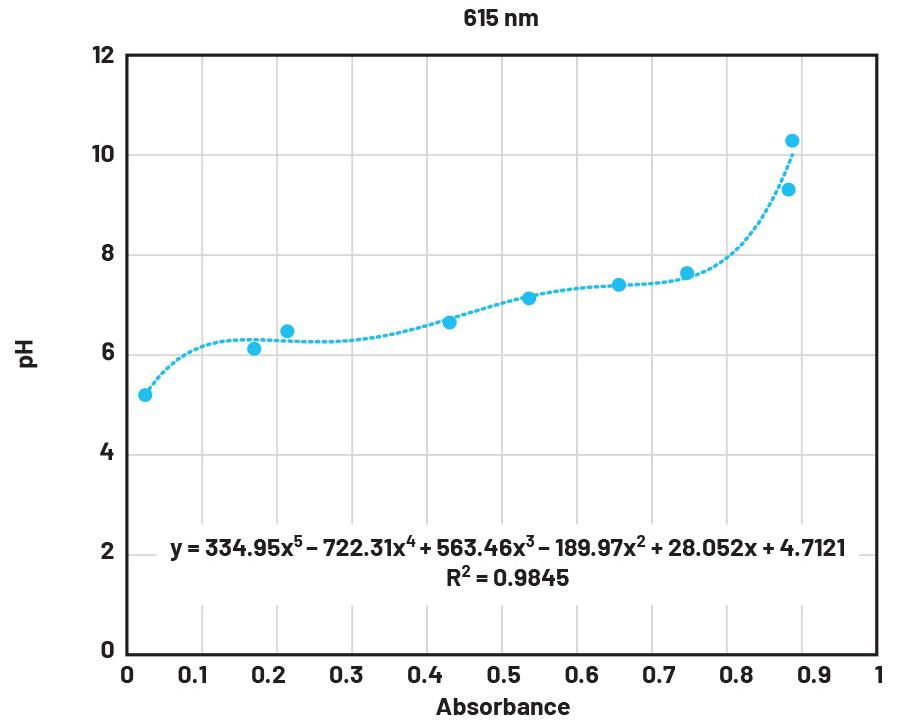
results are reported directly in the desired unit—in this case, pH. This makes it simple to quickly get a result for an unknown sample.
To get the noise value, two different data points were chosen for each wavelength: one lower pH value and one higher pH value. Two points were used because the curve fit was not linear in this case. The standard deviation of a set of repeated measurements for each point, reported as the noise value in Table 1, describes the precision of the measurement, excluding variations in sample preparation.

In each case, the pH vs. absorbance was plotted to create the calibration curve. The Add Trendline option is then used to get an equation for the curve. The equations are then used to determine concentrations of unknown samples. The sensor output is the x-variable, and the resulting y-value is the pH. This can be done by hand; however, the CN0503 can also be used for this. The firmware implements two fifth-order polynomials, INS1 and INS2. Once the polynomials are stored, the INS1 or INS2 mode can be selected so that measurement
LOD is typically determined by measuring noise at low concentration and multiplying by 3 to give a confidence interval of 99.7%. Because pH is a logarithmic scale, pH 7 was chosen as the number to check the LOD, as shown in Table 2.

Turbidity measurements of a liquid sample use the light scattering property of particles suspended in the liquid. Ultimately, it is a measure of the relative clarity of a liquid. The amount of light scattered and the scattering angle differ based on particle size, concentration, and the wavelength of incident light. Measuring turbidity is conducted in many industries, including water quality and life sciences. Besides general turbidity, the CN0503 could be used to determine algae growth by measuring optical density.
Figure 7 shows the optical path for turbidity measurement with a 90° or 180° detector. With the CN0503, turbidity measurements can be made in optical path 1 or 4 only, as a 90° detector is needed. There are various measurement configurations and standards for turbidity. This example demonstrates a modified version of EPA Method 180.1, calibrated and reported in nephelometric turbidity units (NTU).
• CN0503 evaluation board
• EVAL-ADICUP3029 evaluation board
• Hanna Instruments turbidity standard calibration set
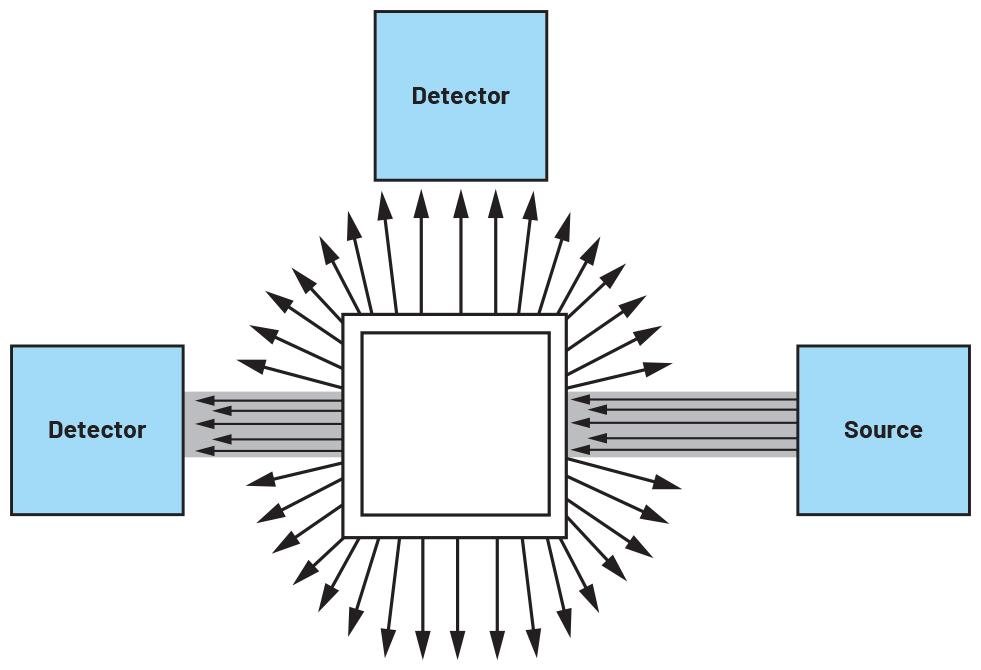
For this experiment, optical path 4 was used with the 530 nm LED board inserted for testing.
Using the CN0503 evaluation GUI, measurement results were exported into Excel. The resulting calibration curve is shown in Figure 9 (p. 52).
The response curve was split into two sections because the 90° scattering measurement is less responsive to high turbidities. One section represents lower turbidity (0 NTU to 100 NTU), and the other higher turbidity (100 NTU to 750 NTU). Two linear fits were then made to each section. Even though there are now two equation values, the CN0503 can still be used to quickly show resulting NTU values. This is
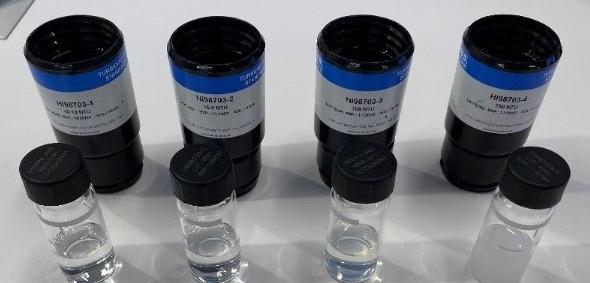
because each optical path can store its own equation values in INS1 and INS2. One important note is that INS1 and INS2 are dependent. The result of the first equation, INS1, is the input variable for the second equation, INS2. Once the equation values are stored, INS1 can be used to measure lowerturbidity samples, and INS2 for higher.
To get the noise value, we choose a data point to take the standard deviation of repeated measurements. The standard deviation is the noise value. One data point is chosen near the bottom of the range because the equation fit is linear.

To determine the LOD, the noise value is measured for a blank or low concentration sample, then multiplied by 3 to represent a 99.7% confidence interval.
When light is shined into a sample containing fluorescent molecules, the electrons move into a higher energy state and then lose some of that energy before emitting light at a longer wavelength. The fluorescence emission is chemically specific and can be used to identify the presence and amount of specific molecules in a medium. In this example, fluorescing chlorophyll was demonstrated by using spinach leaves.


Among many applications, fluorescence measurements are common in biological assays, dissolved oxygen, chemical oxygen demand, and detecting if pasteurization has been successful in milk.
The optical path configuration for fluorescence measurements is shown in Figure 10. With the CN0503, absorbance measurements can be made in optical path 1 or 4 only, which is because of the 90° detector. Usually, a fluorescence detector is positioned at 90° from the incident light and a monochromatic or long-pass filter is used to increase isolation between the excitation and emitted light. Fluorescence is a very sensitive low level measurement and is subject to interference, so the reference detector and the synchronous detection methods are used to reduce error sources.
• CN0503 evaluation board
• EVAL-ADICUP3029 evaluation board
• Spinach solution
For this experiment, a spinach solution was created by blending spinach leaves with water. This was then filtered and kept as the

stock solution. The stock solution was then diluted to result in samples of different percent spinach solution. These were used as standards to create a curve of percent spinach solution through fluorescence. Optical path 1 was used along with the 365 nm LED card and the long-pass filter inserted.
The calibration curve for percent spinach solution is shown in Figure 12.

The trendline equation for this calibration curve can be stored so that the results are directly reported as a percentage by the CN0503.
To get the noise value, two different data points were picked: one near the bottom of
the range and one near the top because the curve fit was not linear. The noise is given by the standard deviation of a set of repeated measurements for each point, as shown in Table 5.

Table 5. Fluorescence Measurement Noise Value.

Table 6. Fluorescence Measurement Limit of Detection.
To determine the LOD, the noise value is measured for a blank or low concentration sample, then multiplied by 3 to represent a 99.7% confidence interval.
Prototyping complex optical liquid analysis measurements is a challenge that requires careful consideration of how chemistry, optics, and electronics interact to produce a precise result. Integrated AFE products like the ADPD4101 pave the way for higher performance optical liquid sensing in smaller spaces.

“HI98703-11 Turbidity Calibration Standards.” Hanna Instruments, Inc.
Optical Platform: Turbidity Measurement Demo. Analog Devices.
ETNdigi is a special digital magazine from ETN. We cover components, test & measurement, radios & networks and the whole scope of embedded software. To put it short: Everything related to electronics & embedded design.


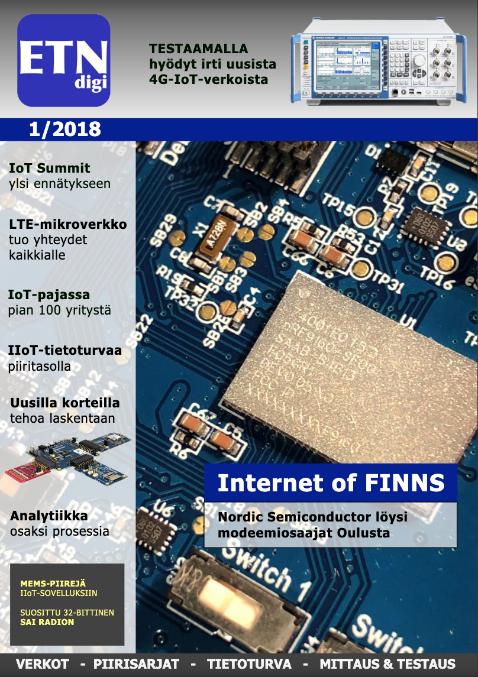

















Want to join us? Just contact ETN editor-in-chief Veijo Ojanperä at vo@etn.fi or our sales manager Anne-Charlotte Lantz at ac@etn.fi. More info about the pricing can be found at etn.fi/advertise.